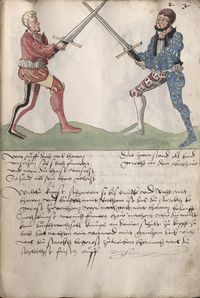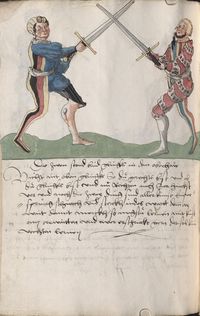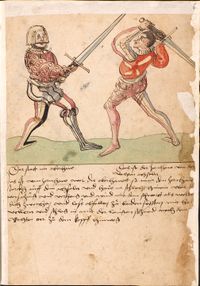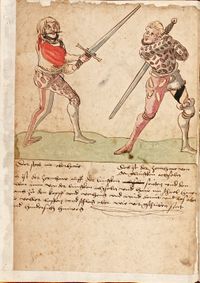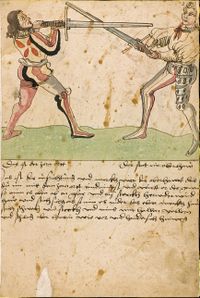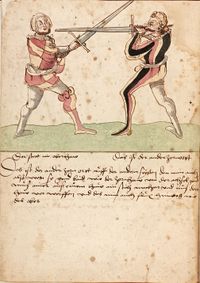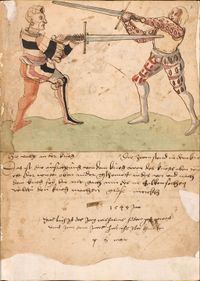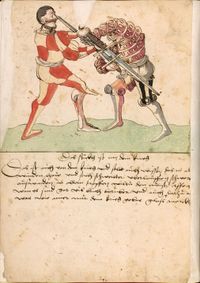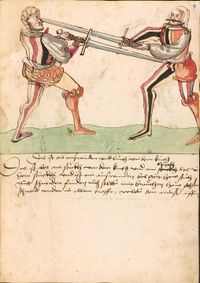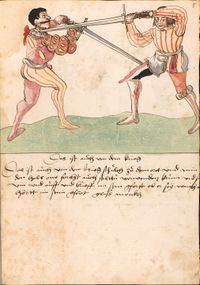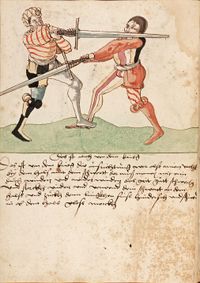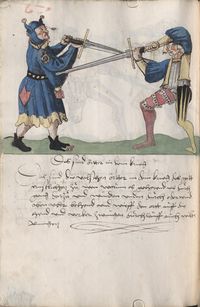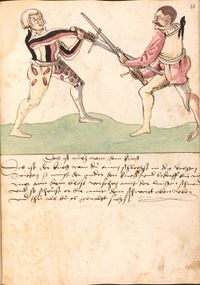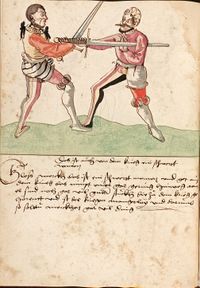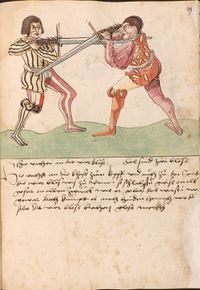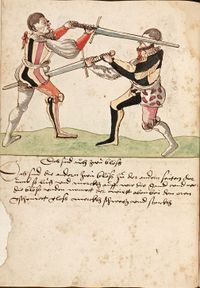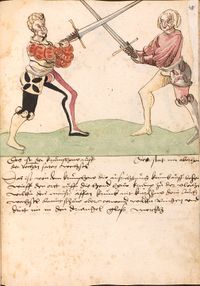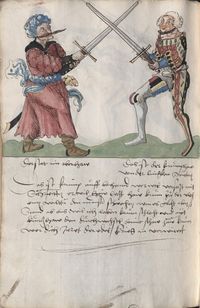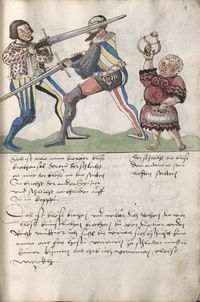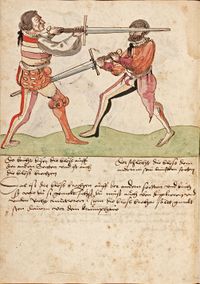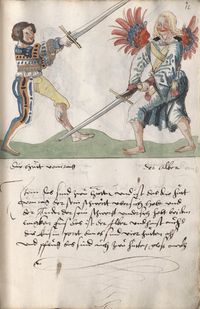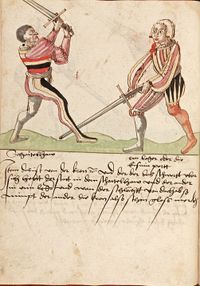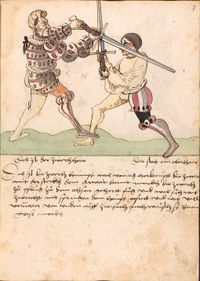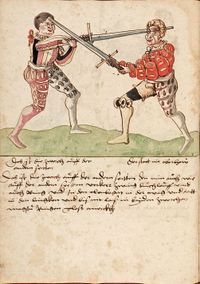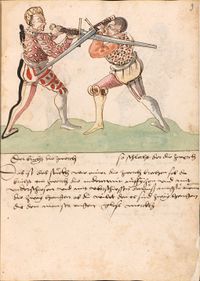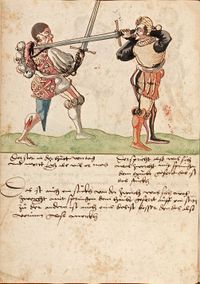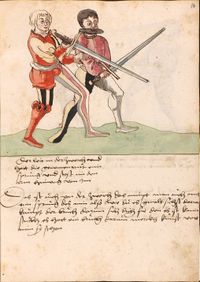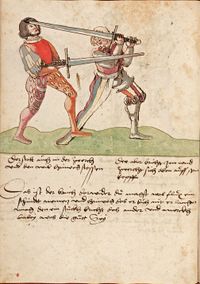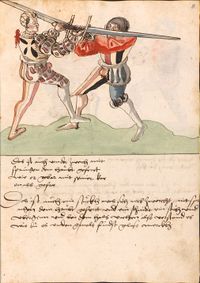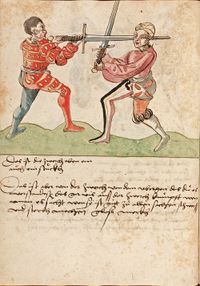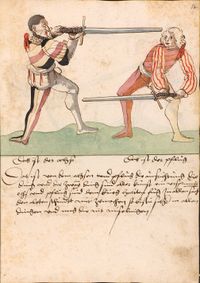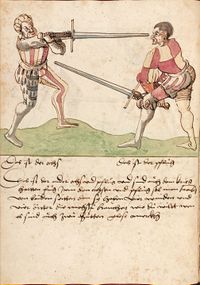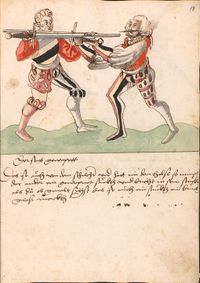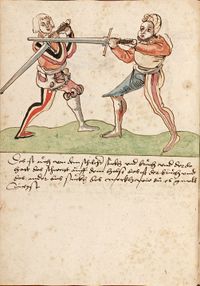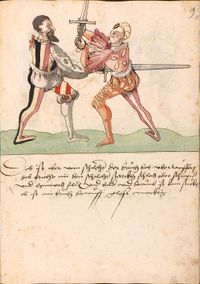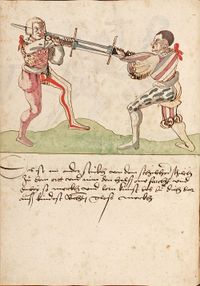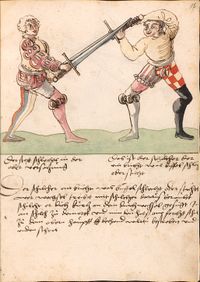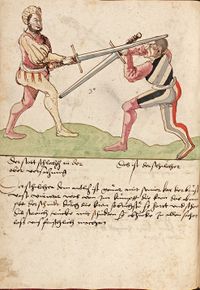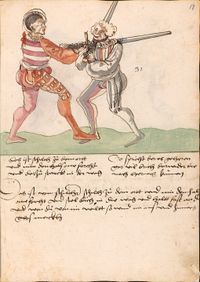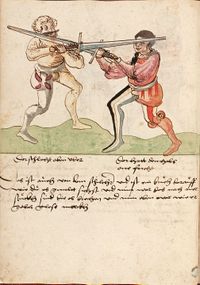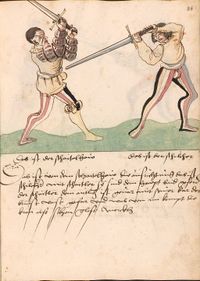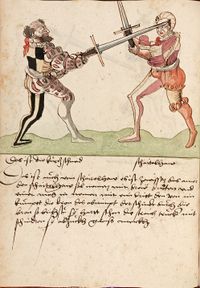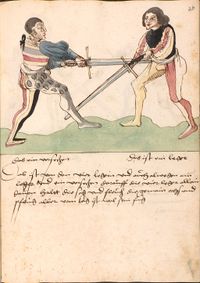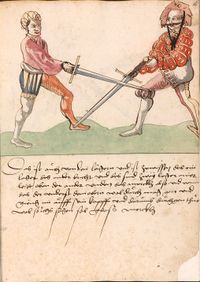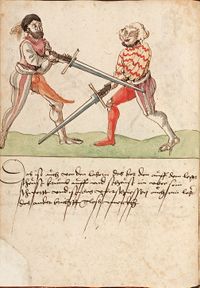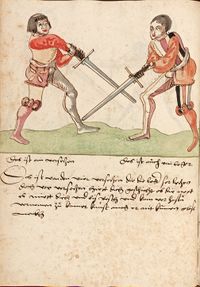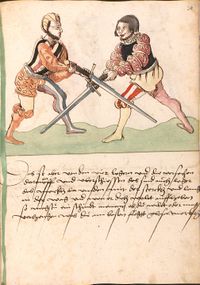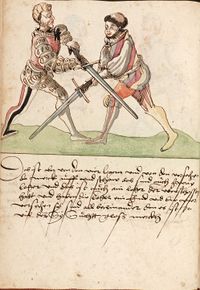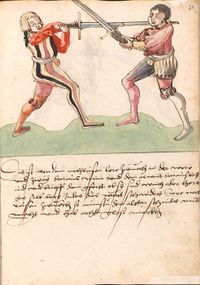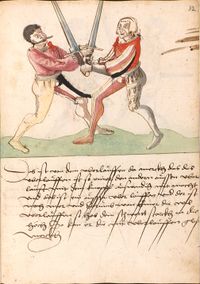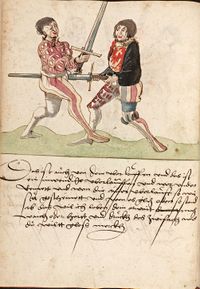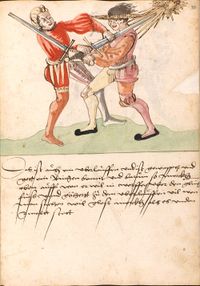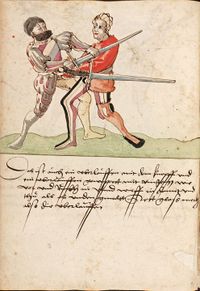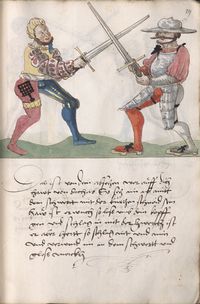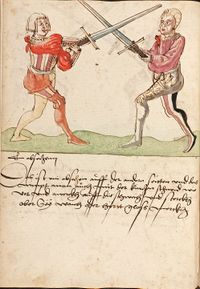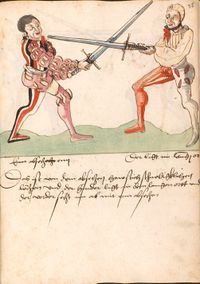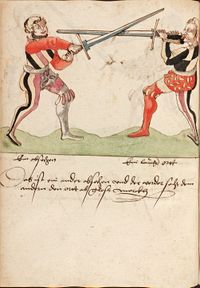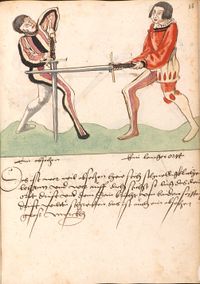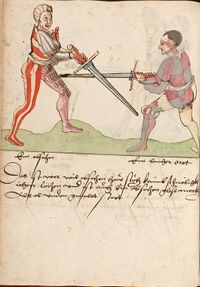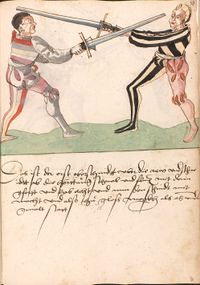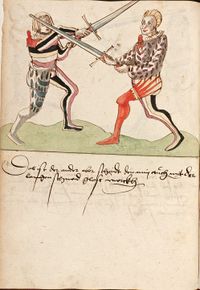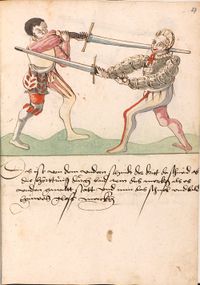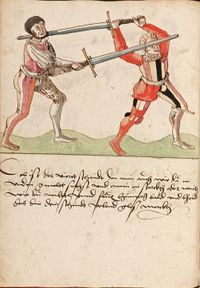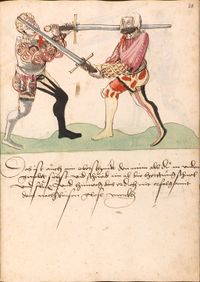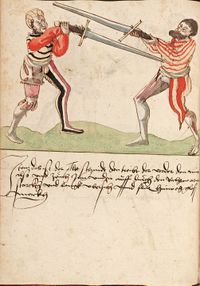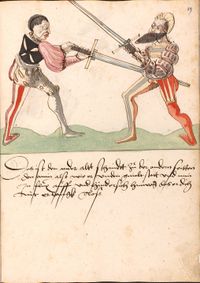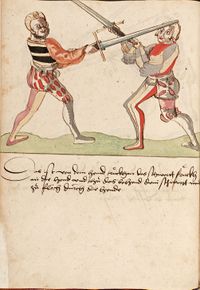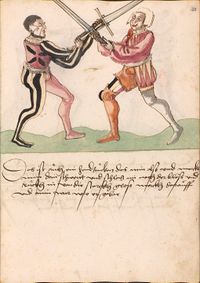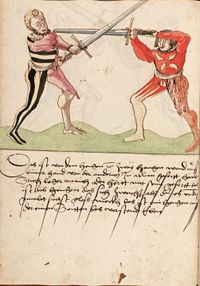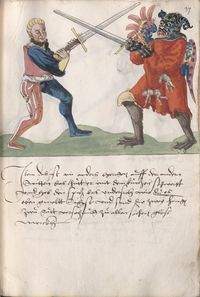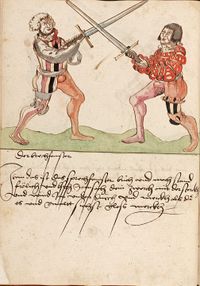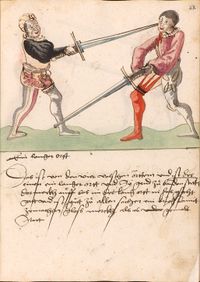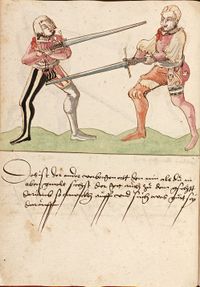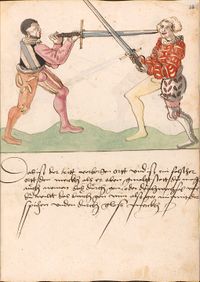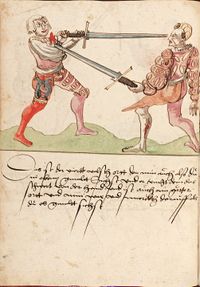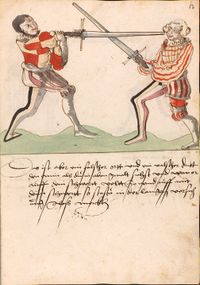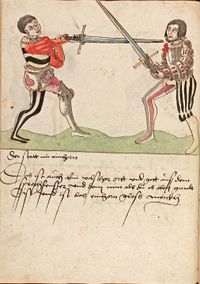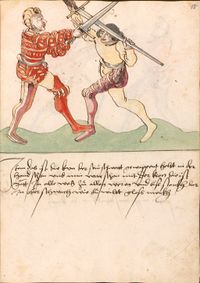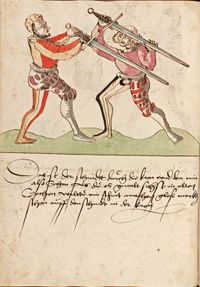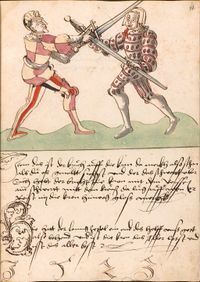|
|
You are not currently logged in. Are you accessing the unsecure (http) portal? Click here to switch to the secure portal. |
Difference between revisions of "Jörg Wilhalm"
| Line 63: | Line 63: | ||
}} | }} | ||
{{foreignchar|Joerg Wilhalm Hutter|ö}} | {{foreignchar|Joerg Wilhalm Hutter|ö}} | ||
| − | '''Jörg Wilhalm Hutter''' was a [[century::16th century]] [[nationality::German]] [[fencing master]]. In addition to his fencing practice, his surname signifies that he was a hatter by trade, a fact that is confirmed in the tax records of Augsburg, Germany in 1501, 1504, and 1516.{{cn}} | + | '''Jörg Wilhalm Hutter''' was a [[century::16th century]] [[nationality::German]] [[fencing master]]. In addition to his fencing practice, his surname signifies that he was a hatter by trade, a fact that is confirmed in the tax records of Augsburg, Germany in 1501, 1504, and 1516.{{cn}} |
| − | Hutter | + | == Treatise == |
| + | |||
| + | There are four works commonly attributed to Hutter: a work on unarmored [[longsword]] fencing in the tradition of [[Johannes Liechtenauer]], works on armored and mounted dueling that appear to be based on those of the early 15th century (relying on obsolete armor designs), and a fourth series of uncaptioned illustrations portraying scenes of judicial dueling. However, it is unclear if Hutter authored all of these works or, like [[Lienhart Sollinger]] and [[Paulus Hector Mair]] afterward, he merely compiled existing works together and placed his name on them as an indication of ownership. The development of the armored dueling treatise can be traced through a draftbook and rough early complete draft, but the same is not true of the unarmored longsword, which appears to be based on the [[Cluny Fechtbuch (Cl. 23842)|MS Cl. 23842]] from the 1490s and is accompanied by a version of the [[pseudo-Peter von Danzig]] gloss that [[Gregor Erhart]] attributes to one Nicolaüs in 1489.<ref>[[Gregor Erhart Fechtbuch (MS E.1939.65.354)|MS E.1939.65.354]], folio [[Page:MS E.1939.65.354 189r.jpg|189r]].</ref> | ||
| + | |||
| + | There are three extant manuscripts of Hutter's treatises written between 1522 and 1523. The oldest of Hutter's manuscripts, [[Jörg Wilhalm Hutters kunst zu Augspurg (Cod.I.6.4º.5)|Cod. I.6.4º.5]],<ref>Generally we refer to manuscripts by their locations for ease of communication, but with three of the ten manuscripts in Augsburg, three in Wolfenbüttel, and two in Munich, that's not really feasible here.</ref> consists of numbered but uncaptioned illustrations of [[armored fencing]] and [[mounted fencing]]; for this reason, Hils assumed it was the draftbook used to develop the others.{{cn}} This draftbook, along with the completed [[Jörg Wilhalm Hutters kunst zu Augspurg (Cod.I.6.2º.3)|Cod. I.6.2º.3]], were created in 1522. In 1523, Hutter seems to have created an accompanying longsword treatise, preserved in the [[Hutter/Sollinger Fechtbuch (Cod.I.6.2º.2)|Cod. I.6.2º.2]]. | ||
| − | Some time after this, all of Hutter's works, | + | Some time soon after this, all of Hutter's works, including the brief series of uncaptioned illustrations, were compiled into the [[Jörg Wilhalm Hutters kunst zu Augspurg (Cgm 3711)|Cgm 3711]]. This manuscript has some oddities not found in the others, including carnival costumes on some of the fighters and a pretzel salesman appearing in the illustration on [[Page:Cgm 3711 11r.jpg|folio 11r]]. It's currently unclear whether Hutter was involved in the creation of this manuscript or not, but it appears to be a presentation copy of the collected works and includes content unique to each of the three earlier manuscripts. |
| − | Hutter's longsword treatise was copied by scultor | + | Hutter's longsword treatise was copied by scultor Gregor Erhart into the [[Gregor Erhart Fechtbuch (MS E.1939.65.354)|MS E.1939.65.354]] in 1533, which was later acquired by Lienhart Sollinger and used as a source for his [[Lienhart Sollinger Fechtbuch (Cgm 3712)|Cgm 3712]]. The Cod. I.6.2º.2 was acquired by [[Paulus Hector Mair]] in 1544, the Codex I.6.4º.5 in 1552, the MS E.1939.65.354 in 1560, and the Codex I.6.2º.3 in 1561. The second was used as the primary source for his writings on armored and mounted fencing; due to its lack of text, he inserted his own descriptions of the devices—descriptions which diverge noticeably from Hutter's own explanations in the Cod. I.6.2º.3. |
| − | + | A final set of manuscripts containing Hutter's work were prepared by Jeremias Schemels von Augsburg in 1589. These contain Hutter's original text, unlike Mair's presentation, but contain details not consistent with any known version of Hutter's work, suggesting that more remain to be discovered. | |
{{master begin | {{master begin | ||
| Line 107: | Line 111: | ||
| {{paget|Page:MS E.1939.65.354|0v|jpg}} | | {{paget|Page:MS E.1939.65.354|0v|jpg}} | ||
| {{paget|page:Cgm 3712|97r|jpg}} | | {{paget|page:Cgm 3712|97r|jpg}} | ||
| − | | | + | | {{paget|Page:Cod.Guelf.38.21 Aug.2º|015r|jpg}} |
|- | |- | ||
| Line 118: | Line 122: | ||
| {{paget|Page:MS E.1939.65.354|04v|jpg}} | | {{paget|Page:MS E.1939.65.354|04v|jpg}} | ||
| {{paget|page:Cgm 3712|97v|jpg}} | | {{paget|page:Cgm 3712|97v|jpg}} | ||
| − | | | + | | {{paget|Page:Cod.Guelf.38.21 Aug.2º|015v|jpg}} |
|- | |- | ||
| Line 131: | Line 135: | ||
| {{paget|Page:MS E.1939.65.354|05v|jpg}} | | {{paget|Page:MS E.1939.65.354|05v|jpg}} | ||
| {{paget|page:Cgm 3712|98r|jpg}} | | {{paget|page:Cgm 3712|98r|jpg}} | ||
| − | | | + | | {{paget|Page:Cod.Guelf.38.21 Aug.2º|016r|jpg}} |
|- | |- | ||
| Line 144: | Line 148: | ||
| {{paget|Page:MS E.1939.65.354|06v|jpg}} | | {{paget|Page:MS E.1939.65.354|06v|jpg}} | ||
| {{paget|page:Cgm 3712|98v|jpg}} | | {{paget|page:Cgm 3712|98v|jpg}} | ||
| − | | | + | | {{paget|Page:Cod.Guelf.38.21 Aug.2º|016v|jpg}} |
|- | |- | ||
| Line 157: | Line 161: | ||
| {{paget|Page:MS E.1939.65.354|07v|jpg}} | | {{paget|Page:MS E.1939.65.354|07v|jpg}} | ||
| {{paget|page:Cgm 3712|99r|jpg}} | | {{paget|page:Cgm 3712|99r|jpg}} | ||
| − | | | + | | {{paget|Page:Cod.Guelf.38.21 Aug.2º|017r|jpg}} |
|- | |- | ||
| Line 170: | Line 174: | ||
| {{paget|Page:MS E.1939.65.354|08v|jpg}} | | {{paget|Page:MS E.1939.65.354|08v|jpg}} | ||
| {{paget|page:Cgm 3712|99v|jpg}} | | {{paget|page:Cgm 3712|99v|jpg}} | ||
| − | | | + | | {{paget|Page:Cod.Guelf.38.21 Aug.2º|017v|jpg}} |
|- | |- | ||
| Line 183: | Line 187: | ||
| {{paget|Page:MS E.1939.65.354|09v|jpg}} | | {{paget|Page:MS E.1939.65.354|09v|jpg}} | ||
| {{paget|page:Cgm 3712|100r|jpg}} | | {{paget|page:Cgm 3712|100r|jpg}} | ||
| − | | | + | | {{paget|Page:Cod.Guelf.38.21 Aug.2º|018r|jpg}} |
|- | |- | ||
| Line 194: | Line 198: | ||
| {{paget|Page:MS E.1939.65.354|10v|jpg}} | | {{paget|Page:MS E.1939.65.354|10v|jpg}} | ||
| {{paget|page:Cgm 3712|100v|jpg}} | | {{paget|page:Cgm 3712|100v|jpg}} | ||
| − | | | + | | {{paget|Page:Cod.Guelf.38.21 Aug.2º|018v|jpg}} |
|- | |- | ||
| Line 205: | Line 209: | ||
| {{paget|Page:MS E.1939.65.354|11v|jpg}} | | {{paget|Page:MS E.1939.65.354|11v|jpg}} | ||
| {{paget|page:Cgm 3712|101r|jpg}} | | {{paget|page:Cgm 3712|101r|jpg}} | ||
| − | | | + | | {{paget|Page:Cod.Guelf.38.21 Aug.2º|019r|jpg}} |
|- | |- | ||
| Line 216: | Line 220: | ||
| {{paget|Page:MS E.1939.65.354|13v|jpg}} | | {{paget|Page:MS E.1939.65.354|13v|jpg}} | ||
| {{paget|page:Cgm 3712|101v|jpg}} | | {{paget|page:Cgm 3712|101v|jpg}} | ||
| − | | | + | | {{paget|Page:Cod.Guelf.38.21 Aug.2º|019v|jpg}} |
|- | |- | ||
| Line 227: | Line 231: | ||
| {{paget|Page:MS E.1939.65.354|14v|jpg}} | | {{paget|Page:MS E.1939.65.354|14v|jpg}} | ||
| {{paget|page:Cgm 3712|102r|jpg}} | | {{paget|page:Cgm 3712|102r|jpg}} | ||
| − | | | + | | {{paget|Page:Cod.Guelf.38.21 Aug.2º|020r|jpg}} |
|- | |- | ||
| Line 238: | Line 242: | ||
| {{paget|Page:MS E.1939.65.354|12v|jpg}} | | {{paget|Page:MS E.1939.65.354|12v|jpg}} | ||
| {{paget|page:Cgm 3712|102v|jpg}} | | {{paget|page:Cgm 3712|102v|jpg}} | ||
| − | | | + | | {{paget|Page:Cod.Guelf.38.21 Aug.2º|020v|jpg}} |
|- | |- | ||
| Line 249: | Line 253: | ||
| <p>[Missing folio]</p> | | <p>[Missing folio]</p> | ||
| {{paget|page:Cgm 3712|103r|jpg}} | | {{paget|page:Cgm 3712|103r|jpg}} | ||
| − | | | + | | {{paget|Page:Cod.Guelf.38.21 Aug.2º|021r|jpg}} |
|- | |- | ||
| Line 260: | Line 264: | ||
| {{paget|Page:MS E.1939.65.354|16v|jpg}} | | {{paget|Page:MS E.1939.65.354|16v|jpg}} | ||
| {{paget|page:Cgm 3712|103v|jpg}} | | {{paget|page:Cgm 3712|103v|jpg}} | ||
| − | | | + | |{{paget|Page:Cod.Guelf.38.21 Aug.2º|021v|jpg}} |
|- | |- | ||
| Line 273: | Line 277: | ||
| {{paget|Page:MS E.1939.65.354|17v|jpg}} | | {{paget|Page:MS E.1939.65.354|17v|jpg}} | ||
| {{paget|page:Cgm 3712|104r|jpg}} | | {{paget|page:Cgm 3712|104r|jpg}} | ||
| − | | | + | | {{paget|Page:Cod.Guelf.38.21 Aug.2º|022r|jpg}} |
|- | |- | ||
| Line 284: | Line 288: | ||
| {{paget|Page:MS E.1939.65.354|18v|jpg}} | | {{paget|Page:MS E.1939.65.354|18v|jpg}} | ||
| {{paget|page:Cgm 3712|104v|jpg}} | | {{paget|page:Cgm 3712|104v|jpg}} | ||
| − | | <!-- | + | | {{paget|Page:Cod.Guelf.38.21 Aug.2º|022v|jpg}}<!-- |
--><section begin="Krumphaw"/> | --><section begin="Krumphaw"/> | ||
|- | |- | ||
| Line 297: | Line 301: | ||
| {{paget|Page:MS E.1939.65.354|19v|jpg}} | | {{paget|Page:MS E.1939.65.354|19v|jpg}} | ||
| {{paget|page:Cgm 3712|105r|jpg}} | | {{paget|page:Cgm 3712|105r|jpg}} | ||
| − | | | + | | {{paget|Page:Cod.Guelf.38.21 Aug.2º|023r|jpg}} |
|- | |- | ||
| Line 310: | Line 314: | ||
| {{paget|Page:MS E.1939.65.354|20v|jpg}} | | {{paget|Page:MS E.1939.65.354|20v|jpg}} | ||
| {{paget|page:Cgm 3712|105v|jpg}} | | {{paget|page:Cgm 3712|105v|jpg}} | ||
| − | | | + | | {{paget|Page:Cod.Guelf.38.21 Aug.2º|023v|jpg}} |
|- | |- | ||
| Line 323: | Line 327: | ||
| {{paget|Page:MS E.1939.65.354|21v|jpg}} | | {{paget|Page:MS E.1939.65.354|21v|jpg}} | ||
| {{paget|page:Cgm 3712|106r|jpg}} | | {{paget|page:Cgm 3712|106r|jpg}} | ||
| − | | | + | | {{paget|Page:Cod.Guelf.38.21 Aug.2º|024r|jpg}} |
|- | |- | ||
| Line 336: | Line 340: | ||
| {{paget|Page:MS E.1939.65.354|22v|jpg}} | | {{paget|Page:MS E.1939.65.354|22v|jpg}} | ||
| {{paget|page:Cgm 3712|106v|jpg}} | | {{paget|page:Cgm 3712|106v|jpg}} | ||
| − | | <!-- | + | | {{paget|Page:Cod.Guelf.38.21 Aug.2º|024v|jpg}}<!-- |
--><section end="Krumphaw"/> | --><section end="Krumphaw"/> | ||
|- | |- | ||
| Line 349: | Line 353: | ||
| {{paget|Page:MS E.1939.65.354|79v|jpg}} | | {{paget|Page:MS E.1939.65.354|79v|jpg}} | ||
| {{paget|page:Cgm 3712|107r|jpg}} | | {{paget|page:Cgm 3712|107r|jpg}} | ||
| − | | | + | | |
|- | |- | ||
| Line 375: | Line 379: | ||
| {{paget|Page:MS E.1939.65.354|23v|jpg}} | | {{paget|Page:MS E.1939.65.354|23v|jpg}} | ||
| {{paget|page:Cgm 3712|108r|jpg}} | | {{paget|page:Cgm 3712|108r|jpg}} | ||
| − | | | + | | |
|- | |- | ||
| Line 388: | Line 392: | ||
| {{paget|Page:MS E.1939.65.354|24v|jpg}} | | {{paget|Page:MS E.1939.65.354|24v|jpg}} | ||
| {{paget|page:Cgm 3712|108v|jpg}} | | {{paget|page:Cgm 3712|108v|jpg}} | ||
| − | | | + | | |
|- | |- | ||
| Line 401: | Line 405: | ||
| {{paget|Page:MS E.1939.65.354|25v|jpg}} | | {{paget|Page:MS E.1939.65.354|25v|jpg}} | ||
| {{paget|page:Cgm 3712|109r|jpg}} | | {{paget|page:Cgm 3712|109r|jpg}} | ||
| − | | | + | | {{paget|Page:Cod.Guelf.38.21 Aug.2º|026r|jpg}} |
|- | |- | ||
| Line 414: | Line 418: | ||
| {{paget|Page:MS E.1939.65.354|26v|jpg}} | | {{paget|Page:MS E.1939.65.354|26v|jpg}} | ||
| {{paget|page:Cgm 3712|109v|jpg}} | | {{paget|page:Cgm 3712|109v|jpg}} | ||
| − | | | + | | {{paget|Page:Cod.Guelf.38.21 Aug.2º|026v|jpg}} |
|- | |- | ||
| Line 425: | Line 429: | ||
| {{paget|Page:MS E.1939.65.354|27v|jpg}} | | {{paget|Page:MS E.1939.65.354|27v|jpg}} | ||
| {{paget|page:Cgm 3712|110r|jpg}} | | {{paget|page:Cgm 3712|110r|jpg}} | ||
| − | | | + | | {{paget|Page:Cod.Guelf.38.21 Aug.2º|025r|jpg}} |
|- | |- | ||
| Line 438: | Line 442: | ||
| {{paget|Page:MS E.1939.65.354|28v|jpg}} | | {{paget|Page:MS E.1939.65.354|28v|jpg}} | ||
| {{paget|page:Cgm 3712|110v|jpg}} | | {{paget|page:Cgm 3712|110v|jpg}} | ||
| − | | | + | | {{paget|Page:Cod.Guelf.38.21 Aug.2º|025v|jpg}} |
|- | |- | ||
| Line 449: | Line 453: | ||
| {{paget|Page:MS E.1939.65.354|29v|jpg}} | | {{paget|Page:MS E.1939.65.354|29v|jpg}} | ||
| {{paget|page:Cgm 3712|111r|jpg}} | | {{paget|page:Cgm 3712|111r|jpg}} | ||
| − | | | + | | |
|- | |- | ||
| Line 460: | Line 464: | ||
| {{paget|Page:MS E.1939.65.354|30v|jpg}} | | {{paget|Page:MS E.1939.65.354|30v|jpg}} | ||
| {{paget|page:Cgm 3712|111v|jpg}} | | {{paget|page:Cgm 3712|111v|jpg}} | ||
| − | | | + | | |
|- | |- | ||
| Line 473: | Line 477: | ||
| {{paget|Page:MS E.1939.65.354|31v|jpg}} | | {{paget|Page:MS E.1939.65.354|31v|jpg}} | ||
| {{paget|page:Cgm 3712|112r|jpg}} | | {{paget|page:Cgm 3712|112r|jpg}} | ||
| − | | | + | | |
|- | |- | ||
| Line 486: | Line 490: | ||
| {{paget|Page:MS E.1939.65.354|32v|jpg}} | | {{paget|Page:MS E.1939.65.354|32v|jpg}} | ||
| {{paget|page:Cgm 3712|112v|jpg}} | | {{paget|page:Cgm 3712|112v|jpg}} | ||
| − | | | + | | |
|- | |- | ||
| Line 537: | Line 541: | ||
| {{paget|Page:MS E.1939.65.354|33v|jpg}} | | {{paget|Page:MS E.1939.65.354|33v|jpg}} | ||
| {{paget|page:Cgm 3712|115r|jpg}} | | {{paget|page:Cgm 3712|115r|jpg}} | ||
| − | | | + | | {{paget|Page:Cod.Guelf.38.21 Aug.2º|027r|jpg}} |
|- | |- | ||
| Line 550: | Line 554: | ||
| {{paget|Page:MS E.1939.65.354|34v|jpg}} | | {{paget|Page:MS E.1939.65.354|34v|jpg}} | ||
| {{paget|page:Cgm 3712|115v|jpg}} | | {{paget|page:Cgm 3712|115v|jpg}} | ||
| − | | | + | | {{paget|Page:Cod.Guelf.38.21 Aug.2º|027v|jpg}} |
|- | |- | ||
| Line 563: | Line 567: | ||
| {{paget|Page:MS E.1939.65.354|35v|jpg}} | | {{paget|Page:MS E.1939.65.354|35v|jpg}} | ||
| {{paget|page:Cgm 3712|116r|jpg}} | | {{paget|page:Cgm 3712|116r|jpg}} | ||
| − | | | + | | {{paget|Page:Cod.Guelf.38.21 Aug.2º|028r|jpg}} |
|- | |- | ||
| Line 576: | Line 580: | ||
| {{paget|Page:MS E.1939.65.354|36v|jpg}} | | {{paget|Page:MS E.1939.65.354|36v|jpg}} | ||
| {{paget|page:Cgm 3712|116v|jpg}} | | {{paget|page:Cgm 3712|116v|jpg}} | ||
| − | | | + | | {{paget|Page:Cod.Guelf.38.21 Aug.2º|028v|jpg}} |
|- | |- | ||
| Line 589: | Line 593: | ||
| {{paget|Page:MS E.1939.65.354|41v|jpg}} | | {{paget|Page:MS E.1939.65.354|41v|jpg}} | ||
| {{paget|page:Cgm 3712|117r|jpg}} | | {{paget|page:Cgm 3712|117r|jpg}} | ||
| − | | | + | | {{paget|Page:Cod.Guelf.38.21 Aug.2º|029r|jpg}} |
|- | |- | ||
| Line 602: | Line 606: | ||
| {{paget|Page:MS E.1939.65.354|42v|jpg}} | | {{paget|Page:MS E.1939.65.354|42v|jpg}} | ||
| {{paget|page:Cgm 3712|117v|jpg}} | | {{paget|page:Cgm 3712|117v|jpg}} | ||
| − | | | + | | {{paget|Page:Cod.Guelf.38.21 Aug.2º|029v|jpg}} |
|- | |- | ||
| Line 615: | Line 619: | ||
| {{paget|Page:MS E.1939.65.354|43v|jpg}} | | {{paget|Page:MS E.1939.65.354|43v|jpg}} | ||
| {{paget|page:Cgm 3712|118r|jpg}} | | {{paget|page:Cgm 3712|118r|jpg}} | ||
| − | | | + | | {{paget|Page:Cod.Guelf.38.21 Aug.2º|030r|jpg}} |
|- | |- | ||
| Line 624: | Line 628: | ||
| {{paget|Page:MS E.1939.65.354|45v|jpg}} | | {{paget|Page:MS E.1939.65.354|45v|jpg}} | ||
| {{paget|page:Cgm 3712|118v|jpg}} | | {{paget|page:Cgm 3712|118v|jpg}} | ||
| − | | | + | | {{paget|Page:Cod.Guelf.38.21 Aug.2º|030v|jpg}} |
|- | |- | ||
Revision as of 14:49, 25 January 2017
| Jörg Wilhalm Hutter | |
|---|---|
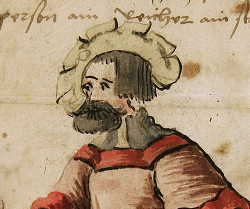 | |
| Born | 15th century |
| Died | 16th century |
| Occupation |
|
| Citizenship | Augsburg, Germany |
| Movement | Augsburg tradition |
| Influences | |
| Influenced | |
| Genres | Fencing manual |
| Language | Early New High German |
| Notable work(s) | Jörg Wilhalm Hutters kunst zu Augspurg |
| Archetype(s) |
|
| Manuscript(s) |
Cgm 3712 (1556)
|
| Concordance by | Michael Chidester |
| Signature | |
Jörg Wilhalm Hutter was a 16th century German fencing master. In addition to his fencing practice, his surname signifies that he was a hatter by trade, a fact that is confirmed in the tax records of Augsburg, Germany in 1501, 1504, and 1516.[citation needed]
Contents
Treatise
There are four works commonly attributed to Hutter: a work on unarmored longsword fencing in the tradition of Johannes Liechtenauer, works on armored and mounted dueling that appear to be based on those of the early 15th century (relying on obsolete armor designs), and a fourth series of uncaptioned illustrations portraying scenes of judicial dueling. However, it is unclear if Hutter authored all of these works or, like Lienhart Sollinger and Paulus Hector Mair afterward, he merely compiled existing works together and placed his name on them as an indication of ownership. The development of the armored dueling treatise can be traced through a draftbook and rough early complete draft, but the same is not true of the unarmored longsword, which appears to be based on the MS Cl. 23842 from the 1490s and is accompanied by a version of the pseudo-Peter von Danzig gloss that Gregor Erhart attributes to one Nicolaüs in 1489.[1]
There are three extant manuscripts of Hutter's treatises written between 1522 and 1523. The oldest of Hutter's manuscripts, Cod. I.6.4º.5,[2] consists of numbered but uncaptioned illustrations of armored fencing and mounted fencing; for this reason, Hils assumed it was the draftbook used to develop the others.[citation needed] This draftbook, along with the completed Cod. I.6.2º.3, were created in 1522. In 1523, Hutter seems to have created an accompanying longsword treatise, preserved in the Cod. I.6.2º.2.
Some time soon after this, all of Hutter's works, including the brief series of uncaptioned illustrations, were compiled into the Cgm 3711. This manuscript has some oddities not found in the others, including carnival costumes on some of the fighters and a pretzel salesman appearing in the illustration on folio 11r. It's currently unclear whether Hutter was involved in the creation of this manuscript or not, but it appears to be a presentation copy of the collected works and includes content unique to each of the three earlier manuscripts.
Hutter's longsword treatise was copied by scultor Gregor Erhart into the MS E.1939.65.354 in 1533, which was later acquired by Lienhart Sollinger and used as a source for his Cgm 3712. The Cod. I.6.2º.2 was acquired by Paulus Hector Mair in 1544, the Codex I.6.4º.5 in 1552, the MS E.1939.65.354 in 1560, and the Codex I.6.2º.3 in 1561. The second was used as the primary source for his writings on armored and mounted fencing; due to its lack of text, he inserted his own descriptions of the devices—descriptions which diverge noticeably from Hutter's own explanations in the Cod. I.6.2º.3.
A final set of manuscripts containing Hutter's work were prepared by Jeremias Schemels von Augsburg in 1589. These contain Hutter's original text, unlike Mair's presentation, but contain details not consistent with any known version of Hutter's work, suggesting that more remain to be discovered.
Images |
Archetype (1523) |
Munich Version I (1523) |
Glasgow Version (1533) |
Munich Version II (1556) |
Wolfenbüttel Version I (1588) | |
|---|---|---|---|---|---|---|
[1] Young knight learn, to have love for god and honor women. Speak to women well and be valiant, so that one shall hear you and also be available thereto. Do not let yourself be deceived by one’s tricks, go with courage to he who does injustice to you, and set your sense to a sincere principle, and to this end learn valiant chivalry, yet practice pinching and jesting with joy. Throw the stones, shoving staves, fencing and wrestling, dancing and jumping, stabbing and jousting, with that should one seem to curry favor with women, yet fencing wants to have pinching and jesting. The heart which easily frightens there, no fencing shall he learn, why whoever loses the art from the sword, he goes hazy, and also makes large sweeps, those softly warped hearts, therefore one hears very many stories, that the hopeless often will be hit, and is a righteous sense that a truth with fencing will be reached and art has not learned. Of that complaint, I myself Jörg Wilhalm Hutter from Augspurg open and ridicule. |
[01r] Jungk Ritter lerne Gott lieb haben und frawen Erm Red frawen wol und bis manlich d[ie] man dan sol hiert dich auch vor liegen darzu las dich nit betrÿegen trag aines manes mutt [ge]gen dem der dir unrecht thutt und setz dein sin in ein herliche sa[ ]z und lern darzu manliche Ritterschaft doch Scha...pffen und sch...zen mit freuden yeben Die stain stösse stangen schieben vechten und Ringen d[u]nzen und springen stechen und turnieren darmÿt sol man schene frawn hofieren doch schnipffen und scherizen vechten wil haben das herze walchr dar schricket gere kain vechten sol er nit Lernen warum wer verlorn die kunst vom schwertt gatt der dumst und auch die grose straich machent die verzug[e]e herzen waich darum hörtt man gar vil sagen Das die verzagtenv oft werdent gschlagen und ist ein doretter Sin das ein War mitt vechten wil kumen hin und kunst nit glernet hatt des klag ich mich Jörg Wilhalm huttmachr von augspurg frie und spott |
|||||
[2] Whoever wants to cut upon you,
If you want to behold the art, then to left and right with cuts and left with right is what you strongly desire to fence. Whoever goes after with cutting allow their art little joy. Cut nearing what you want, no change-through comes to your shield. To head, to body, don’t abandon the fencing, with the whole body fence, what you desire to drive strongly, hereafter what you strike crisply on. |
[02r] Wer auff dich wil hawen,
Wilstu kunst schawen |
[015r] Wer auff dich will hauen,
Wiltu kunst schauwen so bis lingkhs und rechts mit hauwen, und lingks mit rechten ist, das du starcke begerst zu fechten. Wer nach gehen mit hauwen und auff sich kunst wenig frauwen, haue nachent wie du wilt, kein durchwechsel kompt an dein schilt. Zu kopff und leib das fechte nit ??? mit ganztem leib und was du starkh begerst zu treiben ?? umb du schlecht frisch auff. | ||||
[3] The two both stand on the left in the over cut Don’t fight above on the left if you are right handed, and if you are left handed and in the right also severely hindered. Before and after, the two things are the origin of all art. Weak and strong, indes, wait, with that note your work. Thus may you learn your work with art, and whoever frightens easily, he shall not learn to be a fencer. |
[02v] Die zwen stand baid glingks in den oberhaw Vicht nit oben glingks so du gerechts bist |
[015v] Die 2 stehen beid gliurkhs in dem oberhauwen ficht nit oben glinkhs, so du rechts bist, und ob du glinckhs bist, und im rechte auch solt linckhst vor und nach die 2 ding seind aller kunst ein ursprung schwech und starckh, in das wart deiner arbaigt. Damit merckh so magstu lehrnen mit kunst arbaitri und wer erschrikht gern, soll kein fechte lehrnen. | ||||
[4] He stands in the over cut
This is about the wrath cut. Whoever cuts you from above, take the wrath cut strong on your shoulder and cut in straight, over the parry, and hang and wind with the sword as if you want to thwart, and allow to drop to both sides with half failers and hit him with the long edge to the right ear to the head away. |
[06r] Der statt im oberhaw
Das ist vom zornhaw wer dir oberhawet so nim den zornhaw starckh auff dein achseln vnd haw in schlecht hinein vber d[ie] versatzung vnd verheng vnd wind mit dem schwert als welte [?] dich zwerchen vnd lass obfallen zu baiden seÿtten mit hal[b] vellern vnd schlag in mit der langen schneid nach dem Rechten orr zu dem kopff hinweg |
[03r] Der stat in oberhaw
Das ist vom zornhaw. wer dir oberhawt, so nim den zornhaw starchk auff dein achseln und haw in schlecht hinein uber die versazung und vorheng und wind mit dem schwert als welttestu dich zwerchen und lass abfallen zu baiden seitten mit halben vollern und schlag in mit der langen schneid nach der rechten or zu dem koppf hinweg. |
[016r] Der stat ein oberhauwe
Das ist der zorn hauwe wer du oberhaut. so nim den zorn hau starckh auf dem achsel und hauwe im schlecht linein uber die gesatzung, und geheng und wind mit dem schwert als wollstu dich zwerch und lass abfallen zu baiden seitten mit halbern fellen, und schlag in mit der langen schneid nach dem rechte ohr zu dein kopff hinweckt. | |||
[5] He stands in the over cut
This is the wrath cut on the left side, and take the same from the left shoulder and cut him quickly in long to the head and hang and wind with it, and again use the failers, and hit yet again as stands written before and behind. |
[06v] Der stett im oberhaw
[D]as ist der zornhaw auff der lingken achseln seitten vnd den [se]lben nim von der lingken achseln vnd haw im schnel hinein [l]ang zu dem kopff vnd verheng vnd wind damit vnd las aber [d]ie veller laffen vnd schlag aber wie vorgschriben stat [v]nd hindersich hinweg |
[03v] der stat in oberhaw
Das ist der zornhaw auff der lingken Seiten und den selben nim von der lingken achseln und haw in schwer hinein lang zu dem koppf und vorheng und wind damit und lass aber die veller lauffen und schlag aber wie vor geschriben stat und hindersich hinweg |
[016v] Der stat im oberhauw
Das ist der Zorn hauw auff der lingkten seiten und den selben nim von der lingkten achsel, und hauwe im linein lang zu dem kopff, und verheng und wind damit und las aber die veller lauffen, und schlag aber wie vor geschriben stat, und hindersich-weg. | |||
[6] This is the wrath point
This is the direction, and note: whoever cuts you from above, that you penetrate him with the wrath point and if he becomes aware, then take it away above without risk, and be strong here again, wind, cut and stab, if he sees it, then take it low. Note this precisely: cut, stab, weak and strong and take it with half failers, but hit in as before and behind. |
[03r] Das ist der zorn ortt
Das ist die ausrichtung vnd merckh wer dir oberhawet vnd nims mit halben vellern vnd schlag aber hinein wie vor vnd hindersich hinweg |
[04r] das ist der Zornortt
Das ist die ausrichtung und merckh wer dir oberhawet und wins[3] mit halben vellern und schlag aber hinein wie vor und hindersich hinweg. |
[017r] Das ist der Zorn ort
Das ist die aussrichtung, und merkh wer dir oben hauwet, dz im mit dem zorn ort furtringest und wirt er das geware, so nim es oben ohn gefahr, und bis starkh herwider wind, hauwe und stich, sicht ers so nim es wider das eben merckg, hauwe stich, schwech, und starcke und nemb mit halb veller und schlag oben linein, und vor und hindersich hinwecgkt. | |||
[7] He stands in the over cut
This is the other wrath point on the other side, take it also thusly: If they indeed both wrath cut from the shoulder, and one must make a stab from a cut, and the cut must be thrown, and take that also quickly away like the above. |
[03v] Der stett im oberhaw
Das ist der ander zorn ortt auff der andern seÿtten den nim auch also wen sy gand baid wie der zornhaw von der achsel vn[d] mus ainer auss einem haw ain stich machen vnd mus den haw ver werffen vnd das nim auch flux hinweg wie das ober |
[04v] der stat im oberhaw
Das ist der ander zornortt auff der andern seitten den nim auch also wen sÿ gond baid wie der zornhaw von der achsel und mus einer auf einem haw ain stich machen und muss den haw verwerffen und das nim auch flu[chs] hinweg wÿe das ober |
[017v] Der stat ein obehauwe
Das ist der ander zorn ort, auff der ander seitten den nim auch also, wan sei gend baid wie der zorn hauwe von der achsel, und muss einer aus ein hauwe ein stich machen und aus den verwerffen, und dz nim auch fluchs hinweckg wie dz ober. | |||
[8] Here, fences to the war
This is the direction about the war: Whoever’s war aims above, he will be shamed from above low. Indes, before and after, don’t be quick to your war, understand this in all things if you want to make the war. Gloss note. |
[05r] hie vacht an der krieg
Das ist die ausrichtung vonn dem krieg wer des kriegs oben remet gloss merckh |
[018r] Hie fecht an der krieg
Das ist die ausrichtung von dem krieg, wer des kriegs oben renet, der wirt oben nider gescheuet??, Indes vor und nach, dem krieg sei dir nit gach, nim das allen fechten wiltu den krieg machen glossmerkh. | ||||
[9] This play is in the war This is also about the war, and should also know that in all windings, cleave and stab swords, run-over sword, wind out in all exchanges if you want to fool the masters because there are very many breaks about them and also to them, realize how one bares with the war. Gloss note. |
[02v] Das stuckh ist inn dem krieg Das ist auch von dem krieg vnd soltt auch wissen das in al[len] winden wan es sind gar vil brich daruber vnd auch darzu a[?] war wie ainer mit dem krieg gebar gloss merckh |
[05v] das stuckh ist in dem krieg das ist auch von dem krieg und solt auch wissen das in allen winden wan es sind gar vil buch daruber und auch darzu nim war wie einer mit dem krieg gebar gloss merkckh. |
[018v] Das stukh ist in dem krieg Das ist auch von dem krieg, und solt auch wissen dz in allen winden, hauwen, stich schwerter, uberlauffen, schwert auswinden in allen treffen, wiltu der maister oesen wan es seind gan vil bruch daruber und auch darin nim war mit einer mit dem krieg geben glosswerkh. | |||
[10] This is an outer winding and break from the war This is another play from the war and a break of the previous play, and is an outer winding that goes: cut or stab, find slices well. You shall also cut, stab, slice below with need in all exchanges if you want to fool the master. |
[04r] Das ist ein auswinden vnd bruch von dem krieg Das ist aber ain stuckh von dem krieg vnd ain stuckhbruch des vo[r]dern stuckhs vnd ist ein auswinden das geit haw stich gut schneiden finden auch solttu mit |
[06r] das ist ein aus winden und bruch von dem krieg das ist aber ein stuckh von dem krieg und ein bruch des vordren stuckh und ist ein auswinden das geit haw stich gut schneiden finden auch soltu mit |
[019r] Das ist ain auswinden und bruch von dem krieg Das ist aber ein stukh von dem krieg und ain bruch des vor den stukh und ist ain auswinden, das geit hauwe stich gutt schneiden finden auch soltu mit brauchen hauwe, stich, schneid und in alle treffen wiltu den maister esen | |||
[11] This is also about the war This is also about the war: squint to the point and take the neck without apprehension. You shall also turn crooked and search to and on and test his techniques, whether he is soft or hard in his technique. Gloss note. |
[05r] Das ist auch von dem krieg Das ist auch von dem krieg schulch zu dem ortt auch solttu verwenden krum vnd [?] vm vnd auff vnd brieff im seim gefertt ob er seÿ waich o[der] hörtt im sein gförtt gloss merckh |
[06v] das ist auch von dem krieg Das ist auch von dem krieg schulch zu dem ortt auch solttu vor wenden krum und sich vmb und auff und brieff ein sein gefertt ob er seÿ waich oder hërt in sein gefertt gloss merckh |
[019v] Das ist auch von dem krieg Das ist auch dem krieg schileher zu dem ort. und nim den hals one fercht auch soltu verwenden krumb und stich umb und auf und brief in sein gfang ob er sei waich oder hart in sein gfert gloswerkh. | |||
[12] This is also about the war This is about the war. The direction: Whoever rightly fights one with the sword near the neck, he must turn with a winding through and wind again. That goes well weak and strong below and turn your sword at the neck and jerk the left foot behind you and slice him or the neck. Gloss note. |
[05v] Das ist auch von dem krieg Das ist von dem krieg die ausrichtung wer also ainen vacht beÿ dem hals mit dem schwertt der muß nemen mit ein durch winden vnd wider winden das geit gutt schwech vnd sterckh vinden vnd verwend dein schwert an dem halss vnd zuckh denn lingkhen fuss hindersich vnd schneid in ob dem hals gloss merckh |
[07r] Das ist auch von dem krieg das ist auch von dem krieg die ausrichtung wer also ainen vacht beÿ dem hals mit dem schwertt der mus nemen[5] mit ein durch winder und under winden das geit gutt schwech und sterchk unden und verwend dein schwertt an dem halss und zuckh den lingken fuss hindersich und schneid in ob dem halss gloss merckh |
[020r] Das is auch von krieg Das ist auch von dem krieg die ausrichtung wer also ain recht bei dem hals mit dem schwert der muss nemen mit ein durchwinden und wider winden, dz gait gutt schwech und starkh unden un verwend dein schwert an dem hals und zukh den lingkhen fuss hindersich und scheid in ob den hals gloswerkh. | |||
[13] Those are points in the war Those are the false points in the war. They go forth earnestly, because why they pertain to many passages, in addition, windings below through or wind nimbly above to the top and throw the point onto the hands and invert forcing run through also if you want to wrestle. |
[04v] Das sind örtter in dem krieg Das sind die valschen örtter in dem krieg das gat ernstlich zu wen warum es gehörend vil durch geng darzu vnd winden vnden durch oder wind oben vber behend vnd wirff den ortt auff die hend vnd verker zwingen durchlauff auch willtu Ringen |
[07v] Das sind örtter in dem krieg Das sind die valschen örtter in dein krieg das gatt ernstlichen zu wen warum es geherend vil durch geng darzu und winden unden durch oder wind oben uber behend und wirff den ort auff die hend und verker zwingen durch lauff auch wiltu Ringen |
[020v] Dar seind ortter in dem krieg Das seind die falschen örtter in dem krieg dz gat ernstlich? zu wer warumb es gehörend vil durch gang? darzu und winden unden oder oben uber behendt, und wirff den orth auf die hend und verker zwingen durch lauff auch wiltu ringen. | |||
[14] This is also about the war This is the war when you strike someone to the right side, then the other takes the war and needs no more from you than to parry your opening with the long edge and thus he shoots to you with the sword above over, and do as you see it pictured. |
[38r] Das ist auch von dem krieg Das ist der krieg wan du einen schlechst in die Rechten Seitten so nimpt der ander den krieg vnd bedarff dir nit mer dan dein blöss versetzen mit der langen schneid vnd so scheust er dir mit dem schwertt oben vber vnd thu als du es gmaltt sichst |
[08r] Das ist auch von dem krieg Das ist der krieg wan du einen schlechst in die rechten seiten so nimpt der ander den krieg und bedarff dir nit mer dan dein blöss versetzen mit der langen schneid und so scheust er die mit dem schwertt oben uber und thu als du es gemalt sichst |
[Missing folio] |
[103r] Das ist auch vonn dem krieg Das ist der krieg wan du eim schlechst in die rechten seiten so nimbt der krieg und bedarff dir nit mer dan dein blos versetzen mit der langen schneidt und so du scheust er die mit dem schwert und oben uber und thue als du es gemalt sichst |
[021r] Das is auch von dem krieg Das ist auch der krieg wann du ain schlecht in die rechte seitten so nimpt der ander den krieg, und bedauff dir nit mer, dann die blos versetzen mit der langen schneid, und so schaüfft er dir mit dem schwert oben uber? und thue als du oben gemalt sichst. | |
[15] This is also about the war, a sword taking Gloss note: This is a sword taking and goes from the war, which one takes very slightly away, so that there are yet very many good plays which pertain to the war, and is many things of the war, and therefore you should note very many things. |
[38v] Das ist auch von dem krieg ein schwertt nemen Gloss merckh das ist ein schwertt nemen vnd get au[s] dem krieg das nimpt einer gar gering hinweg dan es sind noch gar vil guttr~ stuckh die zu dem krieg gehörentt vnd ist des kriegen mangerleÿ vnd darumb so solttu merckhen gar vil ding |
[08v] Das ist auch von dem krieg ein schwertnemen Gloss merckh das ist ein schwertnemen und get auss dem krieg das nimpt einer gar gering hinweg das es sind noch gar vil gutter stuckh die zu dem krieg gehörentt und ist des kriegen mangerleÿ und darum so soltu merckhen gar vil ding |
[021v] Das ist auch vom krieg ein schwert nemen Glosmerck dz ist ain schwert nemen, und geht aus dem krieg, dz nimpt ainer gar gering hinwerkh, dz es seind nach gar vil gutt stukh die zu dem krieg gehauwen, und ist das kriegs manicherlai, und darumb so soltu merkhen gar vil ding. | |||
[16] Here, fencing to the four openings
Here fence to the openings to the head and also to the side. Know to aim for the four openings, thus you will hit wisely without fear, without all doubt how he bares, you will be well aware of that. Also, it comes after at the end hereafter how you shall break the four openings. Gloss note. |
[39r] Hie vachen an die vier blöss
Hie vachtt an die bloss zum kopff vnd auch zu der Seitt die vier blöss wis das wirstu wir [?] gewar auch kumptt es nach hinden hernach wie du soltt die vier blöss brechen gloss merckh |
[09r] hie vachen an die vier blöss
Hie vacht an die blöss zum kopff und auch zu der Seiten die vier blöss wiss das wirstu wol gewar auch kumpt es noch hinden hernach wie du solst die vier blöss brechen gloss merckh |
[022r] Hie facht an die 4 bloss
Hie facht an die blos zum kopff, und auch zu der seitten die 4 bloss wus zu nemen so schlechstu gerns an alle gefar, an allen zweiffel wie er gebar dz wirstu auch wol gewar auch kumpt es nach hinden hernach, wie du solt die 4 blos brechen glosmerckh. | |||
[17] Those are also two openings Those are the other two openings to the other side, therefore deceive and note on as the whole, and whoever takes the openings below, they will be shamed above near the ears. Gloss note weak and strong. |
[39v] Das sind auch zwu blöss Das sind die andern zwu blöss zu der andern seitten darumb so lug vnd merckh auff wie die gand vnd we[r] die blöß vnden nemett der wirtt oben bei den oren gschemett gloss merckh schwech vnd sterckh |
[09v] Das sind auch zwei blöss Das sind die andern zwei blöss zu der andern seitn darum so lug und merckh auff wie die gand und wer die blöss unden nemet der wirtt oben beÿ den orn geschemet gloss merckh Schwach und starckh |
[022v] Das seind auch 2 blos. Das seind die ande 2 blos, zu der andern seitten, darumb so lug auf wie die gend, und wer die blos unden nemet der wirt oben bei den ohren geschemst? glosmerckh schwech und sterkh. | |||
[18] This is the crooked cut on the right side change
This is about the crooked cut, the direction: Crook on nimbly, throw the point upon the hands. Cut crooked to the flats if you want to weaken the masters. Don’t cut crooked, cut short, with it show your change through, or use if you want to wrestle, and step to him in the triangle. Gloss note. |
[40r] Das ist der krumphaw auff der Rechtñ seiten wechsel
Das ist von dem krumphaw die ausrichtung krumb auff behen[d] oder verwend wilttu Ringen vnd dritt im in den driangel gloss merckh |
[10r] Das ist der krumphaw auff der rechtn Seyten wechsell
Das ist von dem krumphaw die ausrichtung krum auff behend oder verwend wilstu ringen und drit im in den driangel gloss merckh |
[023r] Das ist der krum hauw auff der rechten seitten wechsel
Das ist von dem krumen hauw die ausrichtung krum auf behend wirff den ort auff die hend, hauw krum zu der flech, wiltu den maister schwechen krum nit kurtz hauw dein durchsechsel damit schwech oder hart verwendt wiltu eingehn, und tritt im in den triangel glosmerckh. | |||
[19] He stands in the over cut
That is, crook on nimbly. Whoever parries well with striding, he destroys many cuts. Cut crooked to the flats if you want to weaken the masters. When it sparks above, stand away, that I want to praise. Strike crooked and not short cut, with it show the change through. Cut crooked whoever errs you, the noble war confuses him. |
[40v] Der statt im oberhaw
Das ist krump auff behennd wer wol versetzt |
[10v] Der stat im oberhaw
Das ist krump auff behend wer vol versezt |
[023v] Das stat im oberhauw
Das ist krum auf behend wer wol versetz mit schreitten er vil heu letzt hauw krum zu der flechen, wiltu den maister schwechen, wan es glitz oben, so stand ab dz will ich loben krum schlecht und mit kurtz hauw den durch wechsel damit schlach? krum wer dich irret der edel krieg in verwirret. | |||
[20] This is how one shall break in the four openings: He hits him with opening to the side, thus the other breaks it to him and hits him behind onto his head
This is to break openings, and you want to reckon yourself, artfully break the four openings, you double above, rightly mutate below. I say to you truthfully, no man protects himself without danger. If you have heard, he may come to hit nobody. That I have heard. Gloss note. |
[08r] Das ist wie man die vier blöss brechen sol der ein der schlecht in mit blöss in die seitten so bricht der ander sÿ Im vnd schlöcht in hinden auff sein kopff
Das ist blöss brechen vnd wiltu dich Rechen das hab ich vernomen gloss merckh |
[11r] Das ist wie man die vÿer blöss brechen sol der ein der schlecht in mit der blöss in die seitten So bricht der ander Sy Im und schlecht in hinden auff Sein kopff
Das ist blöss brechen und wilstu dich Rechen das hab ich vernomen gloss merckh |
[024r] Das ist wie man die 4 blos brechen soll der ein schlecht in mit der blos in die seitten, so bricht der ander sei im, und schlecht in hinden auf sein kopf.
Das ist blos brechen, und wiltu dich rechen die 4 blos künstlich brechen du oben doppilier unden recht mutier, ich sag dir fürwar sich? beschitzen kan, wan on gfar hastu vernomen? zu schlagen mag ir kainer kummen dz hab ich vernomen? glosmerckh. | |||
[21] There this breaks the opening on the other side, and is also to break the openings
This is the opening breaking on the other side, and break it as you see pictured. You must also double above, and mutate correctly below. Item: The opening breaking shall stand pictured in front before the crooked cut. |
[08v] Da bricht diser die blöss auff der andern Seitten vnd ist auch die blöss brechen
Das ist die blöss brechen auff der andern seitten vnd brich sÿ wie du si gemalt sichst du must auch oben dupplieren vnd vnden Recht mutieren Item die blöss brechen söltt gmalt sten dauorn vor dem krumphaw |
[11v] Da bricht diser die blöss auff der andern seitten und ist auch die blöss brechen
Das ist die blöss brechen auff der andern seitten und brich sÿ wie du Si gmaltt sichst du must auch oben dupplieren und unden Recht muttie renn Item die blöss brechen soltt gmalt sten dar[uo]n vor dem krumphaw |
[024v] Da bricht diser die blos auf der andern seitten, und ist auch die blos brechen
Das ist die blos brechen, auf der andern seitten, und brich sei wie du gemalt sichst du must auch oben dupplieren, und unden recht mutieren, Item die blos brechen solt gemalt stehn darvon vor der krumhauw. | |||
[22] The guard from the day
Note: These are two guards, and this is the guard from the day. He has his sword raised upwards, and the other has his sword raised downwards beside the left foot. This is the fool and is also called the iron gate. Then there are four guards. Ox and plow, those are also two guards. Gloss note. |
[14r] Die hutt vom tag
Item das sind zwu hutten vnd ist das die hutt von tag de[?] der sein schwertt vbersich hebtt vnd der andr~ der Sein schwertt vndersich hebt beÿ dem lingken fuss das ist der alber vnd haist auch die Eisnin por[tt] dan es Sind vier huttñ ochs vnd pflug das sind auch zwu hutten gloss merckh |
[12r] Die hutt vom tag
Item das sind zwu huttn und ist das die hutt von tag der sein schwertt ubersich hebt und der Ander der sein schwertt undersich hebt bei dem lingken fus das ist der Alber und haist auch die Eisin portt dan es sind vier hutten ochs und pflug das sind auch Zwu hutten gloss merkh |
||||
[23] Skull cut
Item: This is about the crown, etc. and then he raises the sword upwards. He stands in the skull cut, and the other in a position, and when he hits away from the roof, thus the other takes the crown all right. Gloss note. |
[14v] Schaitelhaw
Item das ist von der kron etc vnd der der das schwertt vbersich hebtt der statt in dem schaitelhaw vnd der ander in ein legr~ vnd wan der schlöchtt von dach ab so nimpt der ander die kron also schon gloss merckh |
[12v] Schaitelhaw
Item das ist von der kron [ ] und der der das schwertt ubersich hebt der statt in dem schaitelhaw und der ander in ein leger und wan der schlecht von dach ab so nimpt der ander die kron also schon gloss merckh |
||||
[24] This is the thwart cut
This is the thwart, it takes what comes from the day, then thwart with the strong, with it note your work. The thwart to plow, join hard to the ox, and who thwarts themselves well, with jumping threatens your head, and whoever directs the failer on from below two times aims as he wishes. Gloss note. |
[07r] Das ist der zwerchhaw
Das ist die zwerch benimpt vnd was velle[r] verurrn von vnden auff zwifach nach wunsch sÿ Reren gloss merckh |
[13r] Das ist der Zwerchhaw
Das ist die Zwerch benimpt und was veler veruarn von enden auff [ ] zwiuach nach wunsth Sÿ Rere[ ]tt gloss merckh |
||||
[25] This is the thwart on the other side
This is the thwart on the other side, take it also as on the other side: invert, force, run through, and also wrestle, and in the elbows in the scale and step to the left, and don’t be lazy. You may wrestle in both thwarts. Gloss note. |
[07v] Das ist die zwerch auff der andern seitten
Das ist die zwerch auff der andern seitten den nim auch wie auff der andern seÿtten verkerr zwing durchlauff vnd auch Ring vnd In dem elenbogen in der wag vnd tritt in den lingken vnd bis nit laß in baÿden zwerchen magstu Ringen gloss merckh |
[13v] Das ist die Zwerch auff der amderm seitten
Das ist die zwerch auff der andern seitten den nim auch wie auff der ander Seittn verker zwing durchlauff und auch Ring und in dem Elenpogen in der wag und drit an den lingken und bis nit lass[6] in baiden Zwerchen magstu Ringen gloss merckh |
||||
[26] He breaks the thwart
This is the play of how one shall break the thwart: One thwart breaks there, the other with placing upon and with shooting under and with shooting over. You may take the two hangings from it if you want, then they are two hangings, which is very strict for the man. Gloss note. |
[09r] Der bricht die zwerch
Das ist das stuckh wie einer die zwerch brechen sol da bricht ein zwerch die andern mit aufsÿtzen vnd mit vnderschliesen vnd mit vberschliessen darauß magstu neme[?] die zwaÿ hengen ob du wiltt den es sind zway hengen die den man ser engen gloss merckh |
[14r] Der bricht die Zwerch
Das ist das stuckh wie einer die Zwerch brechen sol da bricht ein Zwerch die andern mit auff sitzen und mit underschiessen und mitt uberschiessen darauss magstu nemen die zway hengen ob du wiltt dan es sind zway hengen die den man ser Engen gloss merkh |
[026r] Der bricht die zwerch
Das ist dz stukh wie ainer die zwerch brechen soll, da bricht ain zwerch die ander mit aufsetzen, und mit under schissen und uberschiessen, daraus magstu nemen die zwai hengen, die der man ser engen glosmerckh. | |||
[27] He stands in the guard from day and raises as much as he likes
This is also a play from the thwart: Whatever thwarts itself well moves to the head with jumping from one side to the other, is also one that is better than that, therefore hear. Gloss note. |
[09v] Der stet in der hutt von tag vnd wertt sich als vil er mag
Das ist auch ein stuckh von der zwerch was sich wol zwercht mit springen dem haubt gefert auff ein seitñ zu der andern ist auch eins das ist besser den das also vernim gloss merckh |
[14v] Der stett in der hutt von tag und wertt sich als vil er mag
Das ist auch ein stuckh von der Zwerch was sich wol zwercht mit springen dem haubt gefertt auff ein seitten zu der andern ist auch eins das ist besser den das also vernim gloss merkh |
[026v] Der stat in der huet vom tag endwerlisch??? als vil er mag.
Das ist auch ain zwerch von der zwerch was sich wol zwercht mit springen dem haupt gefert auf ein seitten zu der andern seitten ist auch ring dz ist besser dann dz vernim? glosmerkh. | |||
[28] He lies in the thwart and has taken it with a jump, and shoves his arm away from him This is also about the thwart: One takes that also with a jump, take that as you see it pictured, thereafter comes the break, therefore it itself is then not a play for you, it has a break. Therefore note art, hear it beautifully. |
[10r] Der leit in der zwerch vnd hatt die genomen mit ein sprung vnd stost im den arm hinweg von Im Das ist auch von der zwerch das nimpt man auch mit ein sprung das nim also wie du es gmalt sichst darna[ch] kumpt der bruch darum sich dich fur dan es ist kain stuckh es hatt ein bruch darum merckh kunst vernim sÿ |
[15r] Der leit in der zwerch und hatt die genomen mit ein sprung und Stost im den arm hinweg von Im Das ist auch von der Zwerch das nimpt man auch mit ein sprung das nim also wie du es gmalt sichst darnach kumpt der bruch dar um sich dich vir dan es ist kain stuckh es hatt ein bruch darum merkh kumst vor nim Sy schon. |
[025r] Der leit? in der zwerch und hatt dir genemen mit ein sprung, und stosst in den arm hinwegkh von im. Das ist auch von der zwerch dz nimpt man auch mit einem sprung, das nim also wie du es gemalt sichst, dar nach kumpt der bruch, darumb sich dich für dann es ist kain stukh es hatt ain bruch merkh kompts wan sei schon.? | |||
[29] He also stands in the thwart, and he wants to shove away
This is the break against it: You may well quickly take a slice, and away from there so that he may not reach you, then one play breaks the other, and note as well what is good for you. |
[10v] Der statt auch in der zwerch vnd den wil hinweg stossen
Das ist der bruch darwider du magst wol flux ein schnidt nemen vnd hinweg das er dich nit er langen mag den ein stuckh bricht das ander vnd merckh dabeÿ was dir gutt Seÿ |
[15v] Der statt auch in der zwerch und der wil hinweg stossen
Das ist der bruch darwider du magst wol fluchs ein schnit nemen und hinweg das er dich nit erlangen mag den ein stuckh bricht das ander und merckh dabei was dir gut Sey |
[025v] Der stat auch in der zwerch und den will hinwegkh stossen.
Das ist der bruch darwider du magst wol flug ein schnit nemen, und hinwegkh das er dich nit erlangen mag dem ain stukh bricht dz ander, und merckh darbei wie dir gutt sei. | |||
[30] That is also driven from the thwart with jumping to the head, how he bares with his turn without fear This is also a play: whatever well thwarts itself driving with jumping to the head, and a slice, a stab and ignore and fence at the neck, therefore understand it as you see pictured above. Gloss note. |
[11r] Das ist auch von der zwerch mit springen dem haubt gefertt wie er gebar mit seiner kar on als gefar Das ist auch ein stuckh was sich wol zwercht mit spr[i]ngen dem haubt gefertt vnd ein schnidt ein stich vnd vbergenn vnd bei dem hals vachen also verstand es wie du es vnden gmalt findst gloss merckh |
[16r] Das ist auch von zwerch mit Springen dem haubt gefertt wie er gebarr mit seiner korr on als gefar Das ist auch ein stuckh was sich wol zwercht mit springen dem haupt gefertt und ein schnidt Ein stich und ubergen und bey dem hals vachen Also verstand es wie du es oben gmalt sichst gloss merckh |
||||
[31] This is the thwart in above, also a play This is yet again about the thwart from the above, so that you then understand it, that very many come from the thwart, if one searches for it, because it is good to make to all things weak and strong. Gloss note. |
[11v] Das ist die zwerch oben ein auch ein stuckh Das ist aber von der zwerch von dem vbergen das du es verstandest das gar vil auß der zwerch kumptt wen man es sucht wan sÿ ist gutt zu allen sachen schwech vnd sterckh machen gloss merckh |
[16v] Das ist der zwerch oben ein auch ein stuckh Das ist aber von der zwerch von dem uber gon das du es verstandest das gar vil auf der zwerch kumpt wen man es sucht wen Sy ist gutt zu allen sachen schwech und sterckh machen gloss merckh |
||||
[32] This is the ox
This is about the ox and plow, the direction: The thing and the second thing are an origin of all art. Ox and pflug are justifiably hard in the war, in all things, with which to make the old slice. Thus you are secure in all things and it may not fail you. |
[12r] Das ist der ochss
Das ist von dem ochsen vnd pflug die ausrichtung die ding vnd die zwaÿ ding sind aller kunst ein vrsprunng ochs vnd pflug sind dem krieg hartten fug In allen sach[ñ] den altten schnidtt mit zemachen so bistu sichr~ in allen dingen vnd mag dir nit mislingen |
[17r] Das ist der ochse
Das ist von dem ochsen und pflug die aufricht ung die ding und die zwei ding sind aller kunst ein ursprung ochs und pflug sind den krieg hartn fug In allen sachen den alttn schnidt mit zu machen so bistu sicher in allen dingen und was der nit mislingen |
||||
[33] This is the ox
This is the other ox and plow and are also justifiably hard in the war. Item: One shall drive the ox and plow from both sides, then they have four windings and four points which you may use as you wish, because they are also two guards. Gloss note. |
[12v] Das ist der ochs
Das ist der ander ochs vnd pflug vnd sind auch dem krieg hartten füg Item den ochsen vnd pflug sol man treibñ von baiden seitten dan sÿ haben vier winden vnd vier örtter die magstu brauchen wie du wiltt wen es sind auch zwu hutten gloss merckh |
|||||
[34] He stands armed[8] This is also about the squinter and has his neck, thus the other takes an armed [half sword] play and breaks his play, as you see it pictured. This is also a play, a break. Gloss note. |
[18r] Der statt gewappet Das ist auch von dem schilchr~ vnd hatt im den halss so nimpt der ander ein gewapnet stuckh vnd bricht in sein stuck[h] als du es gmalt sichst das ist auch ein stuckh ein bruch gloss merckh |
[18r] Der statt gewapent Das ist auch vo em schilchr und hatt im den halss so nimpt der ander ain gewapnet stuckh und bricht Im sein stuckh als du es gmalt Sichst das is auch ein Stuckh ein bruch gloss merckh |
||||
[35] This is also about the squinter, play and break, and there he has the sword on the neck. This is the break and the other the play. Note that as you see it pictured. |
[18v] Das ist auch von dem schilchr~ stuckh vnd bruch vnd der do hatt das schwertt auff dem halss das ist der bruch vnd das ander das stuckh das merckh wie du es gmalt Sichst |
[18v] Das ist auch von dem schelcher stuckh und bruch und der da hatt das schwertt auff den halss das ist der bruch und das ander das stuckh das merckh wie du es gemaltt siehst |
||||
[36] This is again about the squinter, the break, the run over, that strongly breaks his squinter, hit or slice and away from there quickly and soon, and therefore is not a play, it is a break from it. Gloss note. |
[19r] Das ist aber vom schilchr~ der bruch das vber lauffen das bricht im den schilchr~ starckh schlag oder schneid vnd hinweg flux vnd bald vnd darumb ist kain stuckh es ist ain bruch darauff gloss merckh |
[19r] Das ist aber vom schelcher der bruch das uberlauffen das bricht im den schilcher starckh schlag oder schneid und hinweg fluchs und bald und darum ist kain stuckh es ist ain bruch darauff gloss merckh |
||||
[37] This is another play from the squinter. Squint to the point and take the neck without apprehension, and at the same time so note and learn art that you yourself have become accustomed to. Gloss note. |
[19v] Das ist ein ander stuckh von dem schilcher schilch zu dem ortt vnd nim den halss one forcht vnd dabey so merckh vnd lern kunst das du dich dar auß kundest Rechtñ gloss merckh |
[19v] Das ist ain ander stuckh von dem schilcher schilch zu dem ortt und nim den halss one forcht und dabei so merckh und lern kunst das du dich daraus kundest Rechten gloss merckh |
||||
[38] He stands hitting in the above parry
The squinter breaks in what a buffalo hits or stabs. Whoever drives to change, is robbed of it with the squinter. If he squints at you short, to your change-through prevailed against him. Squint to the point and take the neck without apprehension, squint to the upper head nimbly if you want to strive and find beauty. |
[16r] Der stett schlechts in der ober versatzung
Der schilcher ein bricht |
[20r] Der statt schlechts in der ober versatzung
Der schilcher einbricht |
[027r] Der stat schlechts in der oben versatzung
Der schilcher einbricht was biffel schlecht, oder sticht wer wechsel treibt mit schilchen dar aus beraubt? schilchr er dich kurtz an dein durch wechsel gfangt in an schilcher zu dem ort und nim den hals on forcht zu dem obern haubt behend, wiltu besterb~ und vind~ schon. | |||
[39] He stands hitting in the above parry
The squinter is a danger to the face. With its turn, the chest is quickly threatened. What comes from him, the crown takes away. The slice through the crown, thus you break hard and beautifully. Press the strike, withdraw with a slice. In all things, let us make crisply. |
[16v] Der statt schlechtz in der ober versatzung
Der schilcher In allen sachen lass vns frischlich machen |
[20v] Der statt schlechts in der ober versazung
Der schilchr in allen sachen lass un[s] frisch hÿch machen |
[027v] Der steht schlechts in der oben versatzung.
Der schileher dein antlitz ist ganau??? mit seiner klar der breust hast fürwar was von im kompt, die kron dz abnimpt der schnidt durch die kron, so brichstu sei hart und schon die strauch trukg mit schnidt sei abzukht in allen sachen lob und frishlich machen | |||
[40] That is a squint to the point and take the neck without apprehension, and in addition strong into the scale
This is from the squinter. Squint to the point and take the neck without apprehension, and stand into the scales and hold solidly to yourself, and if you want to go away from him, then wind out and away from him. Gloss note. |
[17r] Das ist schilch zu dem ortt vnd nim den hals one forcht vnd darzu starck in der wag
Das ist vom schilchr~ schilch zu dem ortt vnd nim den hal[s] one forcht vnd stel dich in die wag vnd haltt fast an di[ch] vnd wen du von im wiltt so wind im aus vnd hinweg gloss merckh |
[21r] Das ist schilch zu dem ortt und nim den halss one forcht und darzu starckh in der wag
Das ist vom schilchr schilch zu dem ortt und nim den hals one forcht und stel dich in die wag und halt fast an dich und wen du von Im wiltt so wind im auss und hinweg gloss merckh |
[116r] Das ist schilcher zu dem ortt und nim den hals on forcht und darzu starckh in der wag So spricht der es geherend vill vil durch geng darwidr die hernach koment Das ist vom schilcher schilch zu dem ortt und nim den hals on forcht und stel dich in die wag und halt fast an dich und wen du von Im wilt so wind im auss und hinweg gloss merckh |
[028r] Das ist schileher zu dem ort, und nim den hals one fercht und haw starkh in der wag
Das ist von schileher zu dem ort, und nim den hals on fercht, und stell dich in die wag, und halt vast an dich, und wann du von im wilt, so windt im aus und hinwegkh glosmerkh. | ||
[41] He hits above over
This is also from the squinter, and is a break from it, as you see it pictured, and realize that still more plays are which break it, and realize precisely how he bares. Gloss note. |
[17v] Der schlecht oben vber
Das ist auch von dem schilchr~ vnd ist ein bruch darauff wie du es gmaltt sichst vnd nim war das noch mer stuckh sind die es brechen vnd nim eben war wie er gebar gloss merckh |
[21v] Der schlecht oben uber
Das ist auch von dem schilch[er] und ist ein bruch darauff wie du es gmalt sichst und nim war das noch mer stuckh sind die es brechen vnd nim Eben war wie esr gebar gloss merckh |
[028v] Der schlecht oben über
Das ist auch von dem schileher, und ain bruch darauff, wie du dz gemalt sichst und nim war dz nacher stukh sein du des brechen und nim eben wer von er geben glossmerkh? | |||
[42] This is the skull cut
This is about the skull cut, the direction: This is squinter with skuller, the face is threatened. With its turn, the chest quickly threatened, and what comes from him, the crown, all right. Gloss note. |
[24r] Das ist der schaitelhaw
Das ist von dem schaitelhaw die ausrichtung das ist schilchr~ mit schaitler sÿ sind dem hawpt baid geferd der schaitler dem antlitz ist geuar mit seiner kar der brust vast gefar vnd was von im kompt die kron also schon gloss merckh |
[22r] Das ist der schaitelhaw
Das ist von dem schaitelhauw die ausrichtung das ist schilch[e]r mit Schaittler dem antlitz ist gewar mit seiner kar der brust vast gefar vnd was von in kompf die kron also schon gloss merckh |
[029r] Das ist der schaitel hauw
Das ist von dem schaitel hauw die ausrichtung, dz ist schileher mit schaitler den antzlitz ist geuar mit seiner klar der brust vast gefar und was von im kompt die kron also sten glosmerckh. | |||
[43] This is the short edge
This is also about the skull cut. It is to know that one shall take the skull cut with three steps and one may take it with a step, then the crown comes from him, that takes away the slice through the crown. Thus you break it hard and beautiful. Press the sweep, withdraw it with slicing. Gloss note. |
[24v] Das ist die kurtz schneid
Das ist auch vom schaitelhaw es ist zewissen das ainer den schaitelhaw sol nemen mit drew dritten vnd einer mag in nemen mit eim dritt den von im kumptt die kron das abnimpt der schnidt durch die kron so brichstu sÿ hartt schon die straich truck mit schnidten sÿ abzuckh gloss merckh |
[22v] Das ist die kurz schneid
Das ist auch vom schaitelhaw es ist ze wissen das ainer den schaitelhaw sol nemen mit drey dritten und einer mag in nemen mit ein drit der von in kumpt die kron das abnimpt der schneidt durch die kron so brichtstu sy harrt und schon die straich druckh mit schnitten sy abzuckh gloss merckh |
[029v] Das ist die kurtz schneid.
Das ist auch vom schaitelhauw, es ist zu wissen, ainer der schaitel hauw will nemen mit 3 tritten, und einer mag in nemen mit ein tritt der von im kompt die kron dz abnimpt der schnidt durch die kron, so brichstu sei hart und sten die straich mit durch schniten sei ab zucht glosmerkh. | |||
[44] This is a parry
This is about the four positions, and also always a position and a parry from it. The four positions alone, hold from them, it says, and flee the common. Ox and plow, fool from the day is well his right. |
[25r] Das ein versetzen
Das ist von den vier legern vnd auch alwegen ain leger vnd ein versetzen darauff die vier leger allain |
[23r] Das ein versetzen
Das ist von den vier legern und auch alwegen ain leger vnd ein versetzen darauff die vier leger allain |
[030r] Das ist ain versetzen.
Das ist von dem verlegern, allain davon halt, auch allwegen ein legen und ein versetzen, allain dauen halt die sag und fluch die gemain ochs und pflug alber von tag ist sein fucs??. | |||
[45] This is also about the positions and is to know that one position breaks the other, and those are two positions, one lies over, the other under. Therefore note this, and hear that the lowest may well go through the above, and went onto his head, and therefore penetrates. Do well, so I shall say it. Gloss note. |
[26r] Das ist auch von den lägern vnd ist zewissen das ein leger das ander bricht vnd das sind zwaÿ leger ainer leitt oben der ander vnden das merckh also vnd verni[m] das der vnderst dem obern wol durch mag gen vnd gieng im auff sein kopff vnd darumb durchgen thut[t] wol so ichs sagen sol gloss merckh |
[23v] Das ist auch von den legern und ist zewissen das ein leger das ander bricht und das sind zwai leger ainer leitt oben der ander unden das merckh also und ver nim das der underst dem obern wol durch mag gen vnd gieng in auff sein kopff vnd darum durch gen thutt woll so ichs Sagen sol gloss merckh |
[030v] Das ist auch von der legen, und ist zuwissen dz ain leger dz ander bricht, und dz seind zwaierlei ainer lait oben der ander unden, dz merkh also, und nim'n dz underst den obern wol durch mag gehn, und gieng im auff sein kopff, und darumb durch gen thue wol so ich sage soll, glosmerkh. | |||
[46] This is also about the positions, so that he then shoots on crooked on the position, and shoots to the top of his hands sword, and is the shooting over, also a position the other breaks. Gloss note. |
[26v] Das ist auch von den legern das der den auff dem leger scheust krumb auff vnd scheust im vber sein schwertt vnd ist das vberschiessen auch ein legr~ das ander brichtt gloss merckh |
[24r] Das ist auch von den legern das der den auff dem leger scheuest krum auff vnd scheust in vber sein hand schwertt vnd ist das vberschiessen auch ein leger das ander bricht gloss merckh |
||||
[47] This is a parry
This is about the four parries, which severely injure the positions, yet beware of parries, if it happens to you necessary, it hurts you, and be crisp and come before. If you have heard, he may come to no art. Gloss note. |
[25v] Das ist ein versetzen
Das ist von den vier versetzen vnd bis Resch vnd kom vor hastu vernomen zu kainer kunst mag er nit kumen gloss merckh |
[24v] Das ist ein versetzen
Das ist von den vier versetzen vnd ?aus R?esch vnd kum vor hastu ver nomen zu kainer kunst mag er mitt kummen gloss merckh |
||||
[48] This is again about the four positions, and the parry upon it and shooting over. Those are also positions, note that there below with the strong and long into the scale, and if he wants to execute against you, then you may take a slice if you want to, or may hang, whatever fences best to you. Gloss note. |
[30r] Das ist aber von den vier legern vnd die versetzen darawff vnd vberschiessen das sind auch leger das merckh da vnden mit der sterckh vnd lang in der wag vnd wen er dich woltt auffheben so magstu ein schnidt nemen ob du wiltt oder mugs[t] verhengen was dir am basten fiegtt gloss merckh |
[25r] Das ist aber von den vier legern und die versetszen darauff und uberschiess[e]n das sind auch leger das merckh da und ein mit der sterckh und lang in der wag und wen er dich woltt aufheben so magstu ein schnidt nemen ob du wilt oder magst verhengen was dir am best[e]n viegtt gloss merckh |
||||
[49] This is again about the four positions, and from the parry, there note on and watch: those are also two positions, and that is also a position, the shooting-over has, and the positions have an end, and the four parries, they are all side by side, then it is many that it searches. Gloss note. |
[30v] Das ist aber von den vier legern vnd von den versetzen da merck auff vnd schaw das sind auch zwaÿ leger vnd das ist auch ain leger der vberschossn hatt vnd haben die leger ein End vnd die vier versetzen sÿ sind all beieinander dan es ist Ir vil der Sÿ Suchtt gloss merckh |
[25v] Das ist ober von den vier legern vnd von den versetzen da merckh auff vnd schaw das Sind auch zwai leger vnd das ist auch ain leger der vberschossin huot vnd haben die leger ein End vnd die vier versetzen Sy sind all bey ein ander dan es ist ir vil der sy suchtt gloss merckh |
||||
[50] This is about the pursuit. Learn twofold in the scale, and take two from it, and your work begins from it, and test your movements, whether they are soft or hard, learn the same. Indes, that word cuts severely. Pursue twofold, thus you take the old slice with power and have eight. Gloss note. |
[31r] Das ist von dem nach Raisen lere vnd hab achtt gloss merckh |
|||||
[51] This is another pursuit. You should take the pursuit on both sides, step long if you want to stride, because the pursuit is several things, and that is the pursuit when one has hit you and wants to go from you or withdraw, then follow after him and defend yourself. Gloss note. |
[31v] Das ist ein anders nachRaisen den das nachRaisen das Soltu nemen auff baiden seitten tritt lang wilttu schreitten wen das nachreisen ist mangerleÿ vnd das ist das nachRaisen wan einer dich gschlagen hatt vnd wil von dir gen oder abzwchen so volg im nach vnd vorr dich |
[26v] Das ist ein anders nachraissen den das nachraisen das solttu Nemen auff baiden Seitten dritt lang wilttu schreitten wen das nachraisen ist mangerlaÿ und das ist das nachraisen wan einer dich g[e]schlagen hatt und wil von dir gen oder abziechen So volg im nach und wer dich gloss merckh |
||||
[52] This is about the run over, there note that the run-over is thus: one runs over the other outside with the pommel outward with force, and that is an outer run over, and it is still more, and therefore when one wants to run over you, so raise your sword strong in the height, so he can not run-over you. |
[32r] Das ist von dem vberlauffen da merckh das das vberlauffen ist so einer den andern aussen vberlauft mit dem knopff auswendig mit macht vnd das ist ein ausser vber lauffen vnd der ist noch mer vnd darumb wan Einer dir wil vberlauffen so heb dein schwertt starckh in die höch So kan er dir nit vberlauffen glos[s] merckh |
[27r] Das ist von dem vberlauffen da merckh das das vberlauffen ist so einer den andern aussen vberlaufft mit dem knopff auf wendig mit macht vnd das ist ein ausser vberlauffen vnd der ist noch mer vnd darum wan einer dir wil vberlauffen so heb dein schwertt Starckh in die höch so kan er dir nit vber lauffen gloss merckh |
||||
[53] This is also about the run over, and that is an inward run over, and whoever aims below, and when one runs over you, then you will be shamed, and if it sparks above, then set it aside, that I will praise. Make your work soft or hard and press that twofold as you wish. Gloss mark. |
[32v] Das ist auch von dem vber lauffen vnd das ist ein inwendigs vberlauffen vnd wer vnden Remett wie du wiltt gloss merckh |
[27v] Das ist auch von dem vberlauffen vnd das ist ein Inwendigs vberlauffen vnd wer vind[e]n Rennett wie du wiltt gloss merckh |
||||
[54] This is also a run-over, and is armed [half sword], and a wrestling goes with it, and therefore note precisely on when he wants to throw him over the left foot and many pertain to the run over, if one wishes to search. Gloss note as it stands precisely pictured. |
[33r] Das ist auch ein vberlauffen vnd ist gewappet vnd gett ein Ringen damit vnd darum so merckh eben auff wan er wil in werffen vber den gling[ñ] fuss vnnd göhertt zu dem vberlauffen vil wen man suchen wil gloss merckh als es vnden gmaltt statt |
[28r] Das ist auch ein vberlauffen vnd ist gewapp vnntt vnd get ein Ringen damit vnd darum So merckh eben auff wan er wil in werffen vber den glingken fuss vnd gehört zu dem vberlauffen vil wen man suchen will gloss merckh als es oben gmaltt statt |
||||
[55] This is also a run over with the pommel, and a run over armed [half sword] with wrestling as before, and back him and throw him with it and do as stands pictured above. Gloss note, therefore the runs over. |
[33v] Das ist auch ein vberlauffen mit dem knopff vnd ein vberlauffen gewappett mit Ringenn wie vor vnd Ruckh in vnd wirff in damit vnd thu als es vnden gmaltt Stett gloss merck[h] also die vberlauffen |
[28v] Das ist auch ein vberluaffen mit dem knopf vnd Ein vberlauffen gewappet mit Ringen wie vor vnd Ruckh In vnd wirff in damit vnd thu als es oben gmalt statt gloss merckh also die vberlauffen |
||||
[56] This is about the set aside. Whoever cleaves away at you from roof, set his cut away with the sword with the short edge. If he is soft, then let your pommel go around and hit him with the thwart. But if he is hard, then don’t hit and take and turn him at his sword and work. Gloss note as it stands pictured below. |
[34r] Das ist von dem absetzen wer auff dich hawtt von dach ab So setz im ab mit dem schwertt mit der kurtze[n] schneid Sein haw ist er waich so las vmb dein kopf[f] gen vnd schlag in mit der zwerch ist er aber hertt so schlag nit vnd nim vnd verwind im an dein Schwertt vnd arwait gloss merckh als es vnd[ñ] gmaltt statt |
[29r] Das ist von dem absetzen wer auff dich hawt von dach ab So setz im ab mitt dem schwert mit der kurtzen schneid sein hauw ist er waich so lass vnd dein kopff gen vnd schlag in mit der Zwerch ist er aber hertt so schlag nit vnd nim vnd verwend im an dem schwertt vnd gloss merckh |
||||
[57] A set aside This is a set-aside on the other side and one takes that also with the short edge like before, and note on the weak and strong, whether he is soft or hard. Gloss note. |
[34v] Ein absetzenn Das ist ein absetzen auff der andern seitten vnd das nimpt man auch mit der kurtzen schneid wie vor vnd merckh auff die schwech vnd sterckh ober Seÿ waich oder hörtt gloss merckh |
[29v] Ein absetzen Das ist ein absetzen auff der andern Seytten vnd das nimptt man auch mit der kurtzen schneid wie vor vnd merckh auff die schwach vnd sterckh ab er Sey waich oder hartt gloss merckh |
||||
[58] A set aside
This is about the set aside. Cleave, stab, quickly injure, and the man behind lies in the long point, and the man in front sets him aside with a set-aside. |
[35r] Ein absetzetzeenn
Das ist von dem absetzen haw stich schneligklichen lötzen vnd der hinder ligt in dem langen ortt vnd der vorder setzt im ab mit eim absetzen |
[30r] Ein absetzen
Das ist von dem absetzen haw stich schnelig klichen letzen vnd der hinder ligt in dem langen ortt vnd der vorder setzt in ab mit ein absetzen |
||||
[59] A set aside
This is another set aside, and the man in front sets the point of the other aside. Gloss note. |
[35v] Ein absetzen
Das ist ein ander absetzen vnd der vorder setzt dem andern den ortt ab gloss merckh |
|||||
[60] A set aside
This is whoever wants to set-aside, cleave, stab, quickly injure, and whoever wants to stab onto you, thus look that your point hits and his breaks, hits from both sides if you want to step. That is also as a set aside. Gloss note. |
[36r] Ein absetzen
Das ist wer wil absetzen das ist auch ein absetzen gloss merckh |
|||||
[61] A set aside
This is whoever wants to set aside, cleave, stab, crooked, quickly injure, and is also a set aside. Gloss note, as it stands pictured below. |
[36v] Ein absetzen
Das ist wer wil absetzen haw stich krumb schneligk[l]ichen lötzen vnd ist auch Ein absetzen gloss merck[h] Als es vnden gmaltt statt |
[31v] Ein absetzen
Das ist wer wil absetzen haw stich krum schneligklichen letzen vnd ist auch Ein absetzen gloss merckh als Es oben gmalt Statt |
||||
[62] This is the first upper slice to the top of the arms and slice away the hardening fast and quickly with your technique and have eight and take the slice with force, and therefore to do, gloss note, as it stands pictured below. |
[37r] Das ist der erst oberschnidtt vber die arm vnd schneidtt ab die hörttung schnel vnd flux mit deim gfertt vnd hab acht vnd nim den schnidt mit macht vnd also thu glöss merckh als es vnd[ñ] gmalt statt |
[32r] Das ist der erst oberschnidt uber die arm und schneid ab die hörttung schnel und flul mitt dein gfertt und hab acht und nim den schnidt mit macht und also zu thu gloss merckh als es unden oben gmaltt statt |
||||
[63] This is the second upper slice, take it also with the long edge. Gloss note. |
[37v] Das ist der ander ober schnidt den nim auch mit der langen schneid gloss merckh |
[32v] Das ist der ander oberschnidt den nim auch mit der langen schneid gloss merckh |
||||
[64] This is about the lower slice, the third, there slice away the hardening through both arms. Note that as it stands pictured above, and take that fast and soon away from there. Gloss note. |
[27r] Das ist von dem vndern schnidt der dritt da schneid ab die hörttung durch baid arm das merckh als es vnden gmaltt statt vnd nim das schnel vnd bald hinweg gloss merckh |
[33r] Das ist von dem vndern schnidt der dritt da schneid ab die hörttung durch baid arm das merckh als es oben gmaltt statt vnd nim das schnell vnd bald hinweg gloss merckh |
||||
[65] This is the fourth slice. Take it also as you see in the picture below, and take him strong or soft as you want, and quickly away from there soon, and nimbly so that your slice completes to you. Gloss note. |
[27v] Das ist der viertt schnidt den nim auch wie du in vnden gmaltt sichst vnd nim in starckh oder waich wie du wiltt vnnd flux hinweg bald vnd bhend das dir dein schnidt volend gloß merckh |
[33v] Das ist der viertt schnidt den nim auch wie du in vnden gmaltt vinst vnd nim in Starckh oder waich wie du wiltt vnd flu[chs] hinweg bald vnd bhend das dir dein schnidt volendt gloss merckh |
||||
[66] This is also an upper slice. Take it as you see it pictured above, and slice him away the hardening fast and quickly and away from there so that he does not follow you with the pursuit. Gloss note. |
[28r] Das ist auch ain oberschnidt den nim als du in vnden gmaltt sichst vnd schneid im ab die herttung schnel vnd flux vnd hinweg das er dich nit erfolg mit dem nach Reisen gloss merckh |
[34r] Das ist auch ain oberschnidt den nim als du in oben gmaltt sichst vnd schneid im ab die herttung schnell vnd flu[h] vnd hinweg das er dich nit erfolg mit dem nachraisen gloss merckh |
||||
[67] Item: This is the old slice. The man in front drives it, take it thusly, and pull on him below through the right arm strong and long upwards and quickly away from there. Gloss note. |
[28v] Item das ist der Altt schnidt den treibt der vorder den nim also vnd zeuch Im vnden auff durch den Rechten arm starckh vnd langk vbersich vnd flux hinweg gloss merckh |
|||||
[68] This is the other old slice to the other side. Take it thusly as it stands pictured above, and take it up quickly and behind away from there, so that he does not reach you. Gloss note. |
[29r] Das ist der ander altt schnidtt zu der andern seitten den nim also wie er vnden gmalt statt vnd nim In flux auff vnd hindersich hinweg das er dich nit erlangk gloss |
|||||
[69] This is about the hand press. The sword presses into the hands, and do this nimbly: turn your sword to flat through the hands. Gloss note. |
[29v] Das ist von dem hend truckhen das schwertt truckh in die hend vnd thu das behend dein schwertt wend zu flöch durch die hende |
|||||
[70] This is also a hand press. Take it thusly, and note: Take your sword and hit him to the opening and press him from you strong. Gloss note thereon, and realize it how he bares. |
[20r] Das ist auch ein hendtrucken das nim also vnd merckh nim dein schwertt vnd schlag im nach der blöss vnd truckh in von dir starckh gloss merckh darauff vnd nim war wie er gebar |
[36r] Das ist auch ein hend trucken das nim also vnd merckh nim dein schwertt vnd schlag Im nach der bloss vnd truckh In von dir starckh gloss merckh darauff vnd nim war wie er gebar |
||||
[71] This is about the hanging. Two hangings turn out of one hand from the other in all techniques, cleave, stab, position, soft or hard with your technique, that is the hanging, which thwarts itself as you see it pictured above. Gloss note, that is a hanging on the one side, understand that precisely. |
[20v] Das ist von dem hengen etc zwaÿ hengen wend auß einer hand von der andern In allem gefertt haw Stich leger waich oder hörtt mit seim gefertt das ist das hengen das sich zwercht als du es vndñ gmaltt sichst gloss merckh das ist ein hengen au[ff] der einen Seitten das verstand Eben |
[36v] Das ist von dem hengen [w]er zweÿ hengen wend aus ainer hand von der andern In allem gefertt haw stich leger waich oder hertt mit sein gefertt das ist das hengen das sich zwerchtt als du es oben gemalt sichist gloss merckh das ist ein hangen auf der ainen Seitten das verstand eben |
||||
[72] Item: This is another hanging on the other side. He does it with the short sword and raises the point that faces downward, as you see it pictured above, and are the two hangings, two good parries to all things. Gloss note. |
[21r] Item das ist Ein anders hengen auff der andern seitten das thutt der mit dem kurtzen schwertt vnd heb den spitz bas vndersich wie du es vnden gmaltt sichst vnd Sind die zwaÿ hengen zwu gutt versatzung zu allen Sachen gloss merckh |
[37r] Item das ist ain anders hengen auff der andern Seitten das thut er mit dem kurzen schwertt und heb den spitz bas undersich wie du es oben gmaltt sichst und sind die zwaÿ hengn zwei gutt versatzung zu allen sachen gloss merckh |
||||
[73] The broken window Item: This is the speaking window, break and joyfully make the stance, and inspect his play. Your thwart with the strong and wind through to him from below and note as you see it pictured above. Gloss note. |
[21v] Der brechfenster Item das ist das sprechfenster brich vnd mach stand frölich vnd bsich Sein sach dein zwerch mit der sterck[h] vnd wind Im vnden durch vnd merckh als du es vnd gmaltt sichst gloss merckh |
[37v] Der brachfenster Item das ist der sprachfenster brich und mach stand frelich und bsich sein sach dein zwerch mit der sterckh und wind Im unden durch und merchk als du es oben gmalt sichst gloss merckh |
[131v] der sprechfenster Item das ist der sprechfenster und bricht und mach stand frohlich und bsich sein sach zwerch mit der starckh und wind im unden durch und merckh als du es es gmalt sichst gl.. |
|||
[74] A long point This is about the four false points, and is the first, a long point, and they go to both sides. There note that the long point goes to his face, and is good to all things, to make a war with it. Gloss note as you find it pictured precisely. |
[22r] Ein langer ortt Das ist von den vier valschen örttern vnd ist des einen ein langer ortt vnd Sÿ gend zu baiden seittñ dar merckh auff das im der lang ortt in das gsicht gatt vnd ist gutt zu allen sachen ein krieg damit zemachen gloss merckh als es vnden gemalt Statt |
[38r] Ein langer ortt Das ist von den vier valschen örttern und ist das einen ein langer ortt und sÿ gend zu baiden seitten da merckh auff das im der lang ortt im das gsicht gatt und ist gut zu allen sachen ein krieg damit zu machen gloss merckh als du es eben gmaltt vindst |
||||
[75] This is the second secret point, take that as you see it pictured above, it also goes to the face. Therefore note on and search for what is good from it. |
[22v] Das ist der ander verborgen ortt den nim als du in oben gmalt sichst der gett auch zu dem gsichtt darumb so merckh auff vnd sich was gutt seÿ darauff |
[38v] Das ist der ander verborgen ortt den nim als du in oben gmaltt sichst der gett auch zu dem gsicht darumb so merckh auff und such was gutt Seÿ darauff |
||||
[76] This is the third secret point, and is a false point. Note it as it stands pictured above. You may also take the going-through or change through as you want. Take the going-through thusly: go through to him with the point below. Gloss note. |
[23r] Das ist der tritt verborgen ortt vnd ist ein falscher ortt den merckh als er oben gmaltt statt du mags[t] auch nemen das durch gen oder durchwechsel wie du wilt das durch gen nim also gee im mit der spitzen vnden durch gloss merckh |
[39r] Das ist der tritt verborgen ortt vnd ist ein valscher ortt den merckh als er oben gmaltt Statt du macgst auch nemen das durchgen oder durchwechsel wie du wilst das durchgen nim also gee in mit der spitzen vnden durch gloss merckh |
||||
[77] This is the fourth false point. Take it thusly as you see it pictured above, and he gets the sword through to him from the hand, and is also a good point and realize and note on it, as you see it pictured above. |
[23v] Das ist der viertt valsch ortt den nim auch also du in oben gmaltt Sichst vnd er tringt dem das schwert von der hand vnd ist auch ain gutter ortt vnd nim war vnd merckh darauff als du es gmaltt sichst |
[39v] Das ist der viertt valsch ortt den nim auch also du in oben gmaltt siyst vnd er dringt dem das schwertt von der hend vnd ist auch ain gutter ortt und nim war vnd merckh darauff Als du es oben gmaltt siehst |
||||
[78] This is again a false point, and a false step. Take it as you see it pictured above, and when he falls onto your sword, wind on with your sword, thus you stand in the long parry. Gloss note. |
[13r] Das ist aber ein falscher ortt vnd ein valscher dritt den nim als du in oben gmalt sichst vnd wan er auff dein schwertt veltt So wind auff mit dein schwertt so stastu in der langen versatzung gloss merckh |
[40r] Das ist aber ein valscher ortt vnd ein valscher dritt den nim als du in oben gmalt siehst vnd wan er auff dein Schwert veltt so wind auff mit dein schwert so stanstu in der langen versatzung gloss merckh |
||||
[79] He stands in the unicorn This is a false point and goes from the speaking window, and take it as you see it pictured above, and is the unicorn. Gloss note. |
[13v] Der statt im einhorn Das ist auch Ein valscher ortt vnd gett auß dem sprechfenster vnd denn nim als du es oben gmalt Sist vnd ist das einhorn gloss merckh |
[40v] Der stat im einhorn Das ist auch ein valscher ortt vnd gett aus dem sprechfenster vnd den nim als du es oben gmaltt sichst vnd ist das einhorn gloss merckh |
||||
[80] Item: This is the crown. He holds his sword armed in the hand nicely, and realize it already with the crown, it is good in all scales, to all defenses, and be strong in it or weak as you want. Gloss note. |
[15r] Item das ist die kron der sein schwertt gewappent heltt in der hand schon vnd nim war schon mit der kron die ist gutt In alle weg zu allen weren vnd biss starckh dar In oder schwach wie du wiltt gloss merckh |
[41r] Item das ist die kron der sein schwert gewappent heltt in der hand schon vnd nim war schon mit der kron die ist gutt in alle weg zu allen weren vnd bis starckh darin oder schwach wie du wiltt gloss merckh |
||||
[81] This is the slice through the crown, and take that all right as you see it pictured, in all things, if you want to make a slice. Gloss note nicely on the slice in the crown. |
[15v] Das ist der schnidtt durch die kron vnd den nim also Schon Als du es gmalt sichst in allen Sachen wilttu ein schnit machen gloss merckh schon auff den schnidt in der kron |
[41v] Das ist der schnidt durch die kron vnd den nim also schon als du es gmaltt sichst in allen sachen wilttu ein schnitt machen gloss merckh schon auff den schnidt in der kron |
||||
[82] Item: This is the break onto the crown, there note all right as you see it pictured, and he raises sword upwards, it breaks the crown with the grasping at the sword with the cross, look upon it, because he wrenches the crown away to him. Gloss note. Here the long recital has an end, and that god help us nimbly, and the crown is the very last, and is the very best. |
[41r] Item das ist der bruch auff die kron da merckh also schon als du es gmaltt sichst vnd der das schwertt vber Sich hebt der bricht die kron mit dem Reissen am schwertt mit dem kreutz da lug auff wen er Reist im die kron hinweg gloss merckh Hie hatt der lanng zettel ein end vnd das helff vnss gott also behend vnd ist die kron das Aller letst vnd ist das aller best etc 1 5 2 3 |
[42r] Item das ist der bruch auff die kron da merckh also schon als du es gmaltt sichst vnd der das schwertt vbersich hebt der bricht die kron mitt dem reissen ain schwertt nit dem kreuz da lug auff wen er reisst in die kron hinweg gloss merckh Hie hatt der lang zetall ein End das helff vns gott also behend vnd ist die fron das Aller lotst vnd ist das aller best 1 5 2 3 |
For further information, including transcription and translation notes, see the discussion page.
Additional Resources
References
- ↑ MS E.1939.65.354, folio 189r.
- ↑ Generally we refer to manuscripts by their locations for ease of communication, but with three of the ten manuscripts in Augsburg, three in Wolfenbüttel, and two in Munich, that's not really feasible here.
- ↑ windest
- ↑ korrigiert aus »halben«
- ↑ from ehert
- ↑ loss
- ↑ Treibn?
- ↑ Meaning as though armored
- ↑ At the end of the first line “zwiuach” is written with an “h” which is a scribal error.
- ↑ Note: different hand
- ↑ Same hand as previous.
- ↑ Change in scribe's hand?
- ↑ schnidt
- ↑ Change in hand

